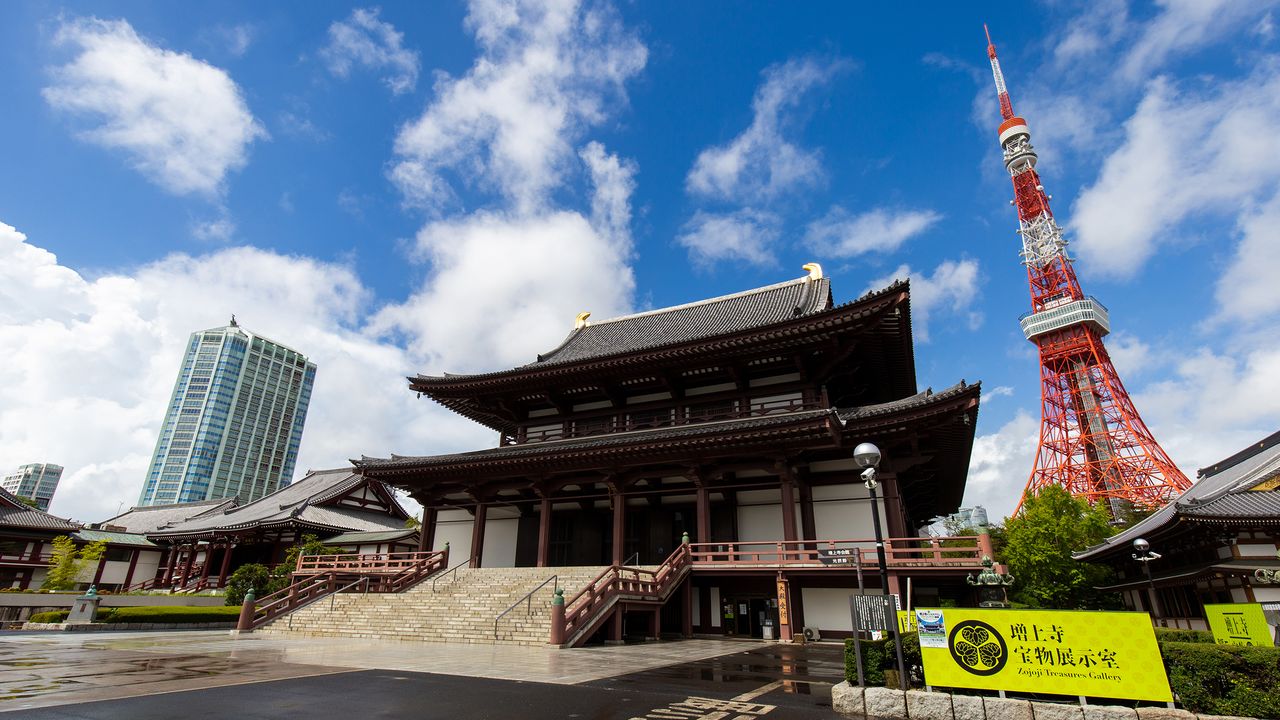
Zōjōji: Buddhist Temple to Shōguns at the Foot of Tokyo Tower
Guideto Japan
Travel History- English
- 日本語
- 简体字
- 繁體字
- Français
- Español
- العربية
- Русский
The Buddhist temple Zōjōji is a treasure-trove of history nestled in the heart of Tokyo. Founded in 1393 by the priest Shōsō as a center of Jōdo Buddhism, during the Edo period (1603–1868), it was the family temple of the ruling Tokugawa clan. Today, visitors can tour the final resting place of several shōguns along with the temple’s impressive collection of historic artifacts. Zōjōji retains its importance for followers of the Pure Land sect, but also attracts sightseers and photographers who come to admire the contrasting scene of temple buildings and Tokyo Tower, which soars nearby.
Zōjōji prospered under Tokugawa patronage, starting with shogunate founder Tokugawa Ieyasu (1543–1616), and grew to be a leading Buddhist institution in the feudal capital of Edo (now Tokyo). The temple declined in prominence following the Meiji Restoration of 1868, but remained a repository of Edo-period architecture. However, most of the ornate buildings that stood on the grounds were destroyed in the allied bombing of the capital during World War II.
One of the few structures that survived the conflagration is the main gate, the Sangedatsumon. Standing an impressive 21 meters high and 19 meters wide, the elegant vermillion entryway looks out on the bustling thoroughfare of Hibiya-dōri. Built in 1622, it is the oldest wooden building in Tokyo and registered as a National Important Cultural Property.
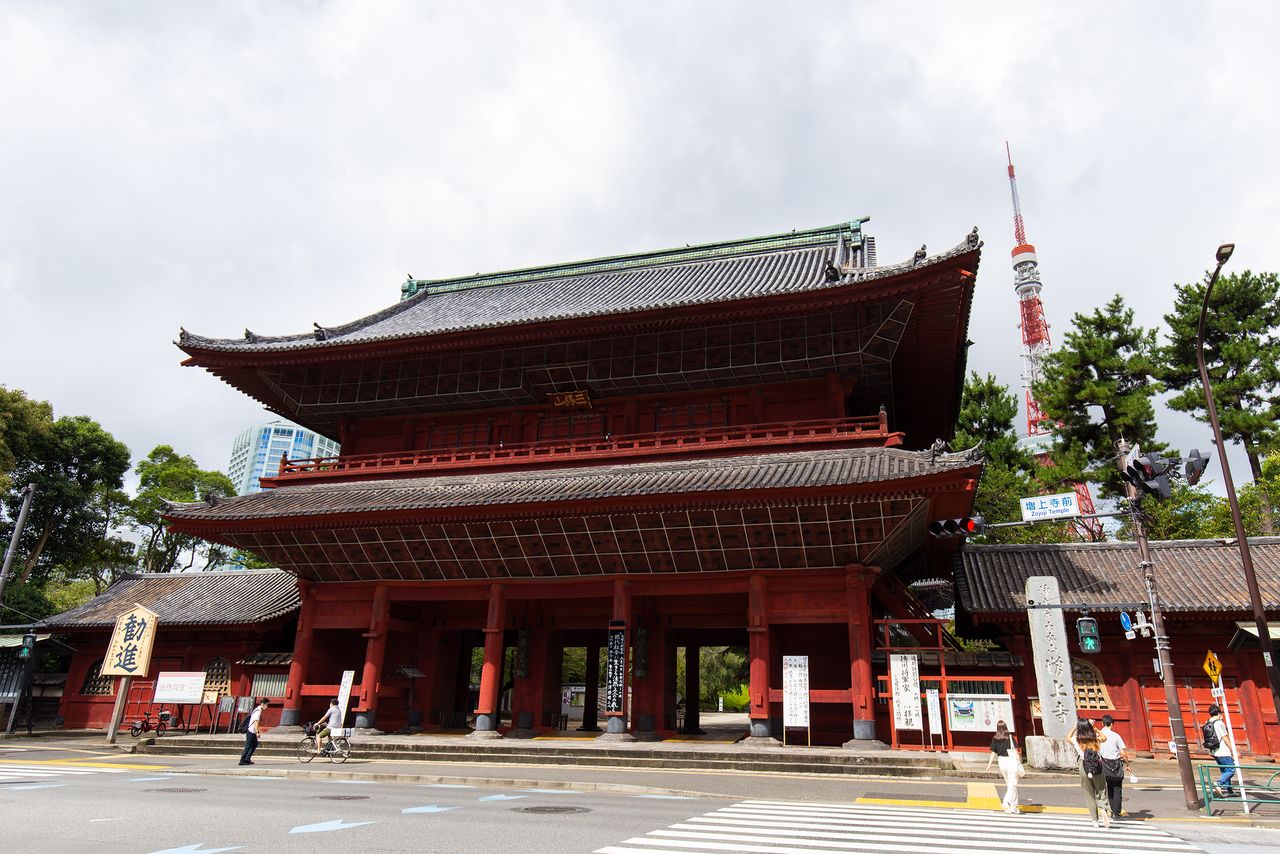
The Sangedatsumon with Tokyo Tower peeking through in the background.
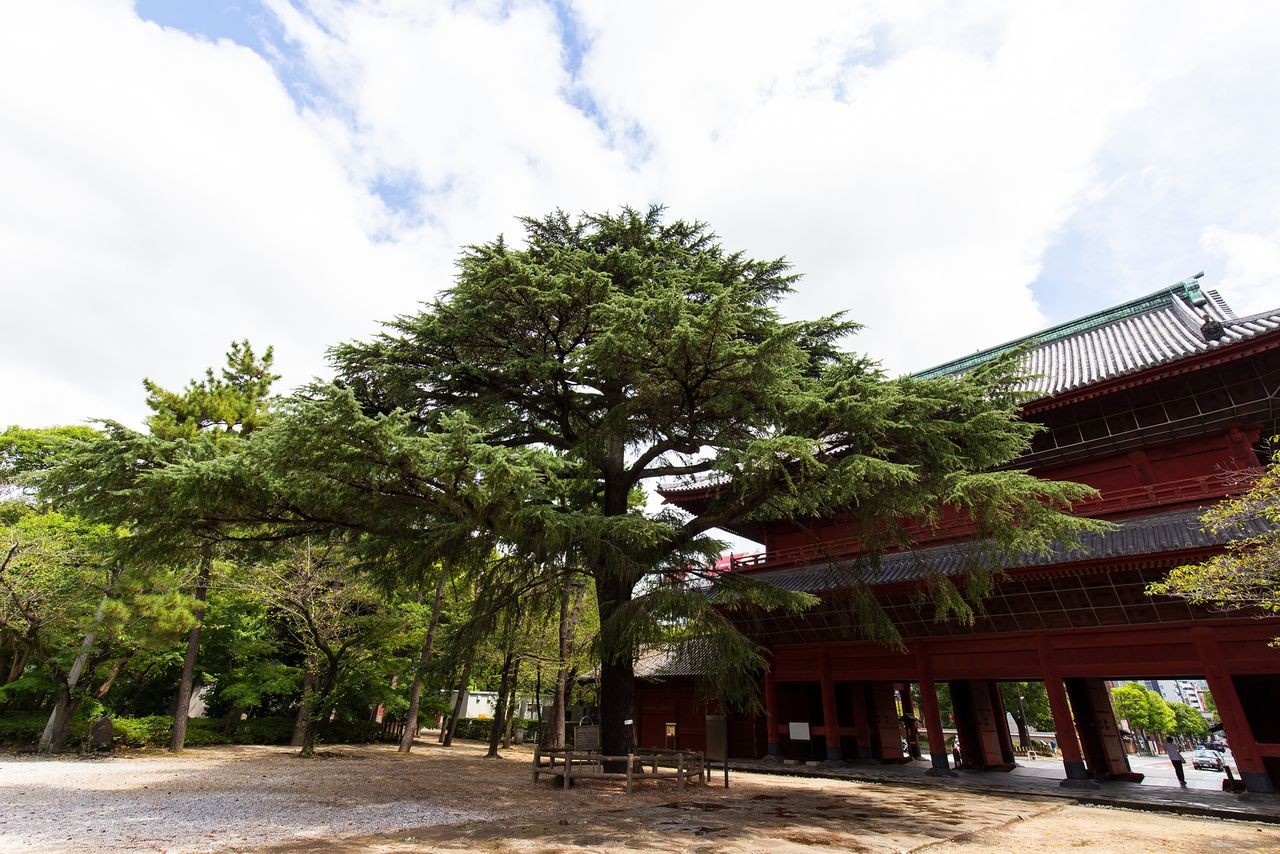
A pine planted by US President Ulysses S. Grant, who visited Japan with his wife in 1879 after leaving office, stands just inside the gate.
Sightseers who pass through the gate’s red-lacquered pillars and upturned eaves will find a tranquil setting of trees, stone statues, and open spaces. Matsunaga Hakuchō, who heads the temple’s visitors office, says that Zōjōji draws comparatively few tourists for a site of such historic importance, a lamentable situation he attributes to the loss of so many traditional structures in the wartime air raids. Although diminished in grandeur, the precincts still boast ample evidence of the temple’s illustrious past, including the tombs of six Tokugawa shōguns and notable figures like Princess Kazunomiya.
Matsunaga notes that the growth of social media has brought a welcome uptick in visitors who tour the temple grounds or come to photograph the Sangedatsumon and other buildings together with Tokyo Tower. He recommends that along with snapping photos, sightseers also pay their respects at the Daiden, the temple’s main hall. “My hope is that visitors will first come to the hall to recite the nenbutsu—Namu Amida Butsu—before exploring the precincts,” he remarks. “Afterward, they can take photos to their heart’s content.”
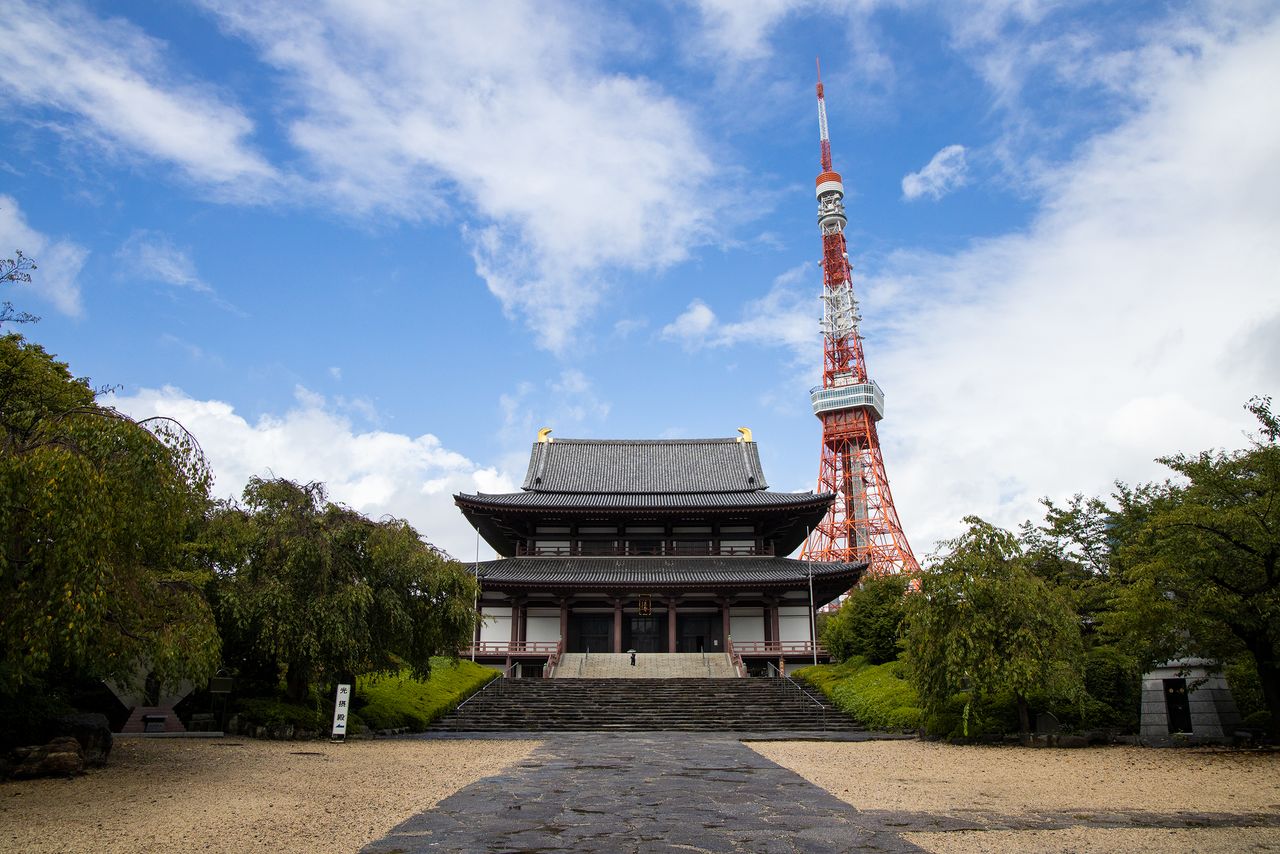
The Daiden, or “great hall,” of Zōjōji together with Tokyo Tower.
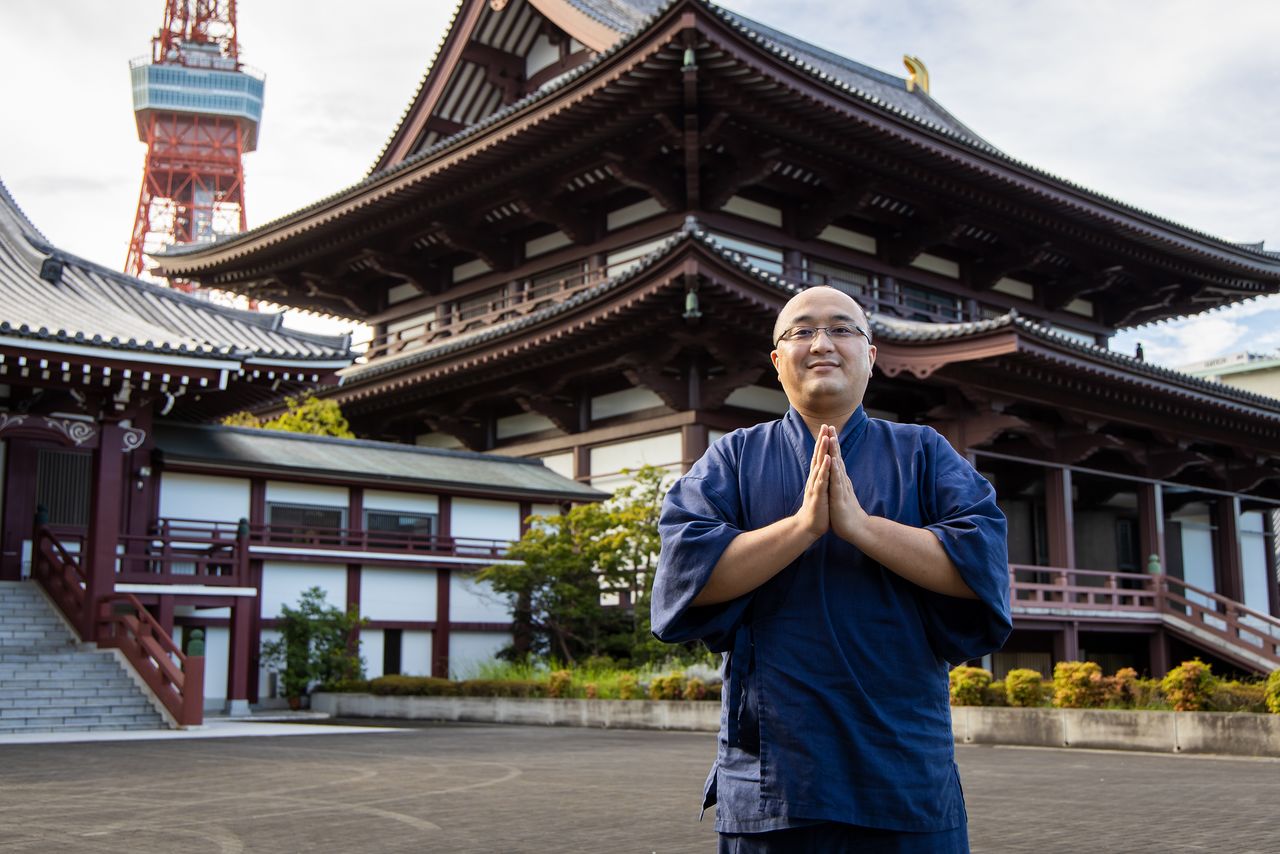
Matsunaga Hakuchō shares Zōjōji’s history with visitors.
Temple to Shōguns
Jōdo Buddhism was founded in Japan in 1175 by the legendary priest Hōnen, who preached that individuals could achieve salvation and be reborn in the Gokuraku-jōdo, the Buddhist land of pure bliss, through the single-minded recitation of the nenbutsu. The Daiden houses a large wooden image of Amida Nyorai, the Buddha of Infinite Light and principal deity of the Pure Land sect, that dates from the Muromachi period (1333–1568). The carving is flanked by statues of Hōnen and Shandao, a seventh-century Chinese priest whose writings influenced the development of Jōdo schools in Japan.
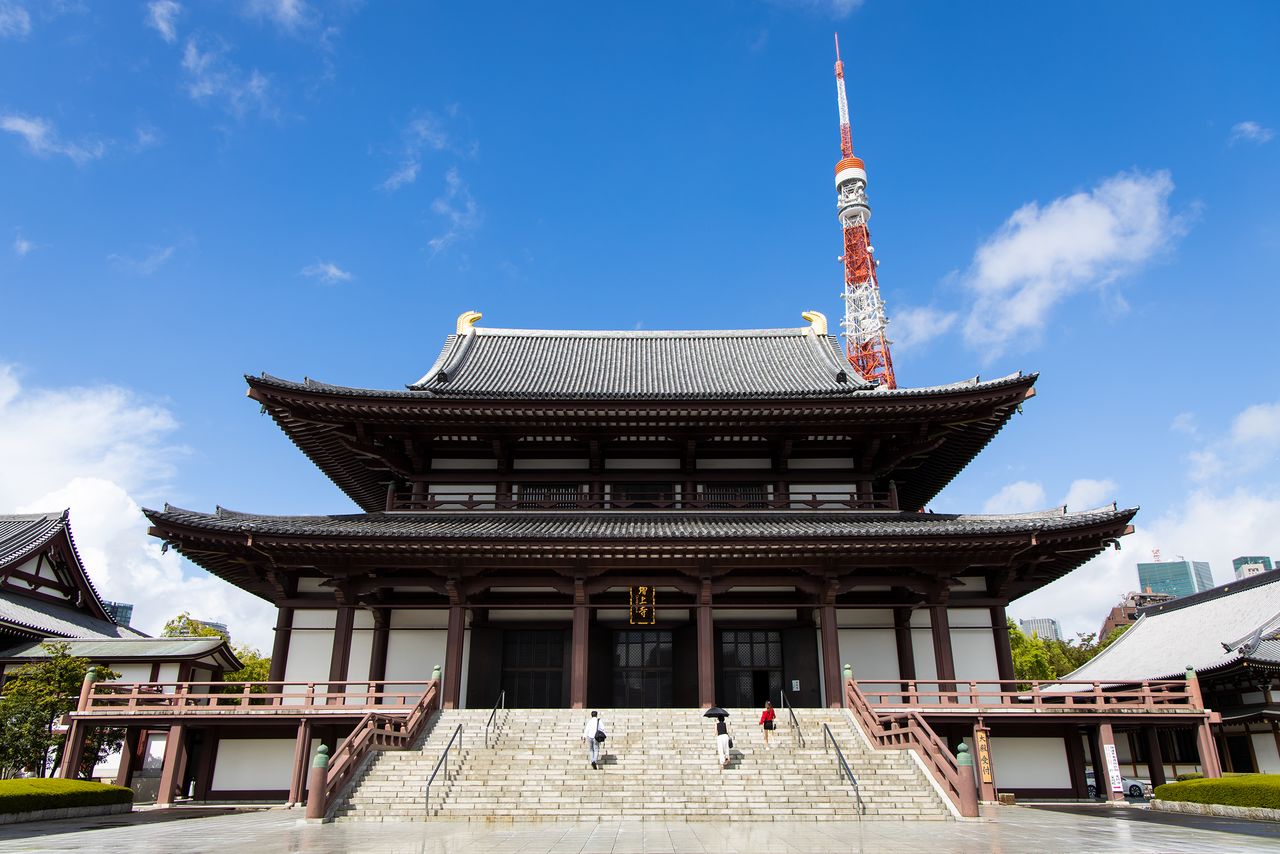
Zōjōji’s proximity to Tokyo Tower creates a unique backdrop for photos and film. Japanese fashion brand Atsushi Nakashima debuted its 2021 spring and summer collection on the steps of the Daiden.
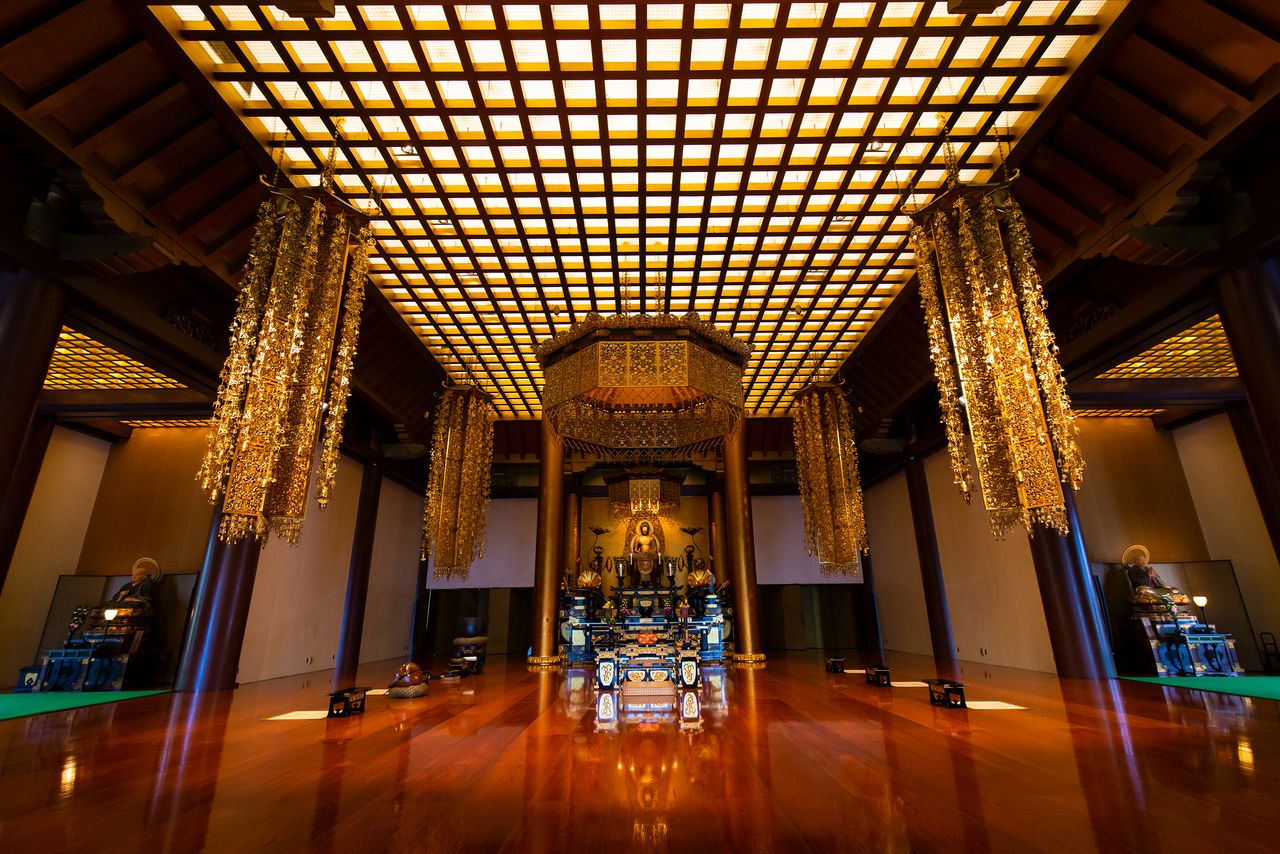
The figure Amida Nyorai, flanked by images of the priests Hōnen, left, and Shandao.
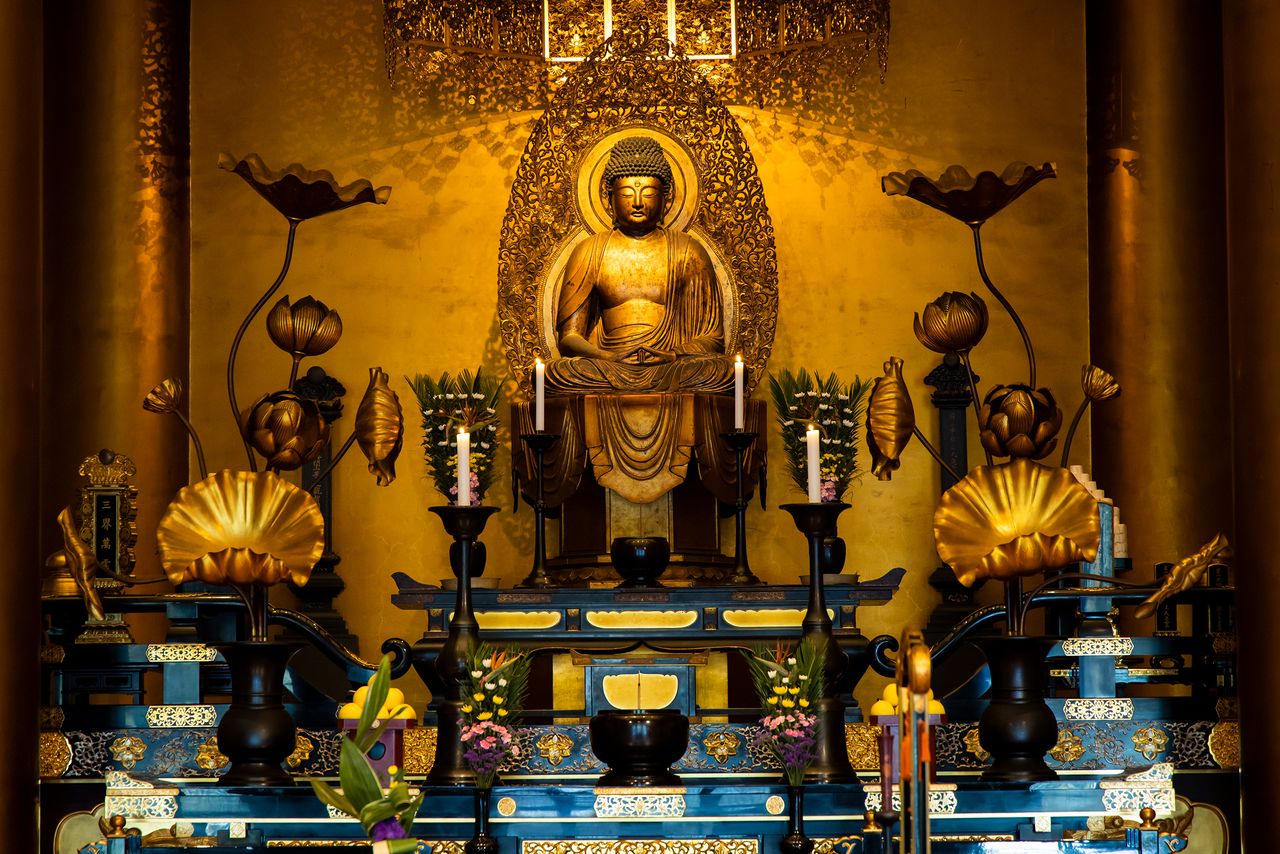
The seated figure of Amida Nyorai at center is registered as a Tokyo Cultural Property.
Zōjōji became the family temple of the Tokugawa clan through a circuitous connection with the Ieyasu’s home province of Mikawa (now Aichi Prefecture). Matsunaga explains that Ieyasu grew up in the powerful Matsudaira clan and would visit the family temple Daijuji, which today stands in the Aichi city of Okazaki. Daijuji was established by the priest Gutei, a disciple of Zōjōji’s founder Shōsō. Ahead of making Edo his provincial base in 1590, Ieyasu consulted with the abbot of Daijuji about selecting a family temple for the newly formed Tokugawa clan. The abbot recommended Zōjōji, whose head priest Zonnō deeply impressed the warlord.
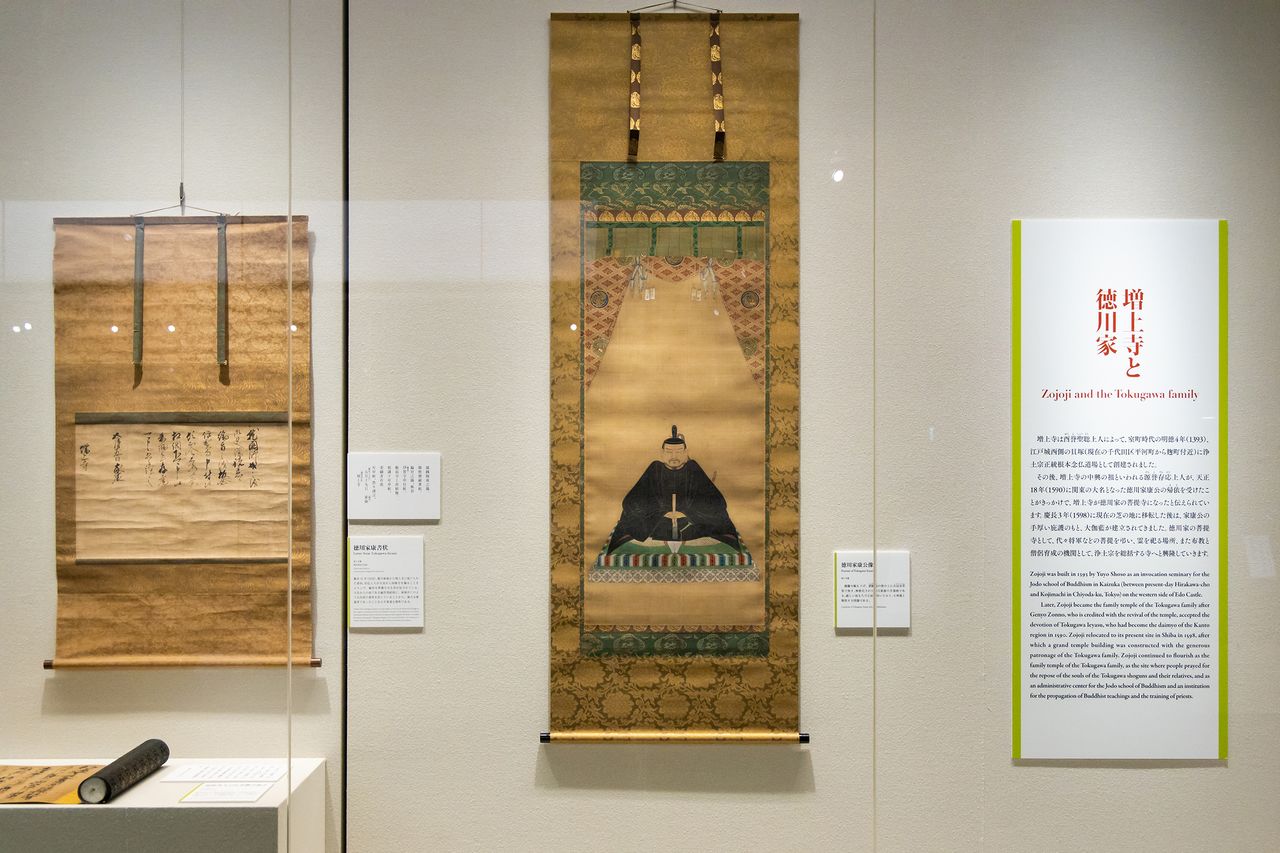
A painting of Tokugawa Ieyasu and message by the warlord in honor of priest Zonnō at the Zōjōji Treasury Gallery.
Zōjōji originally stood in Kaizuka to the west of Edo Castle in what is now the neighborhood of Kioichō in Chiyoda. Ieyasu moved the temple to its current location southwest of the castle in 1598 to guard the fortress from misfortune emanating from that inauspicious direction. (In 1625, the temple Kan’eiji was established in Ueno for the same purpose, protecting the castle to the northeast.)
The first Tokugawa ruler to be buried at Zōjōji was second shōgun Hidetada. Over centuries of Tokugawa rule, he was joined by the shōguns Ienobu (sixth), Ietsugu (seventh), Ieshige (ninth), Ieyoshi (twelfth), and Iemochi (fourteenth). Ieyasu himself was interred at Nikkō in the sprawling Tōshōgū in present-day Ibaraki Prefecture, as was third head Iemitsu, while other Tokugawa rulers rest at the clan’s second family temple, Kan’eiji. The original shōgun mausoleums at Zōjōji were destroyed during the war and the graves relocated to new tombs on the temple grounds.
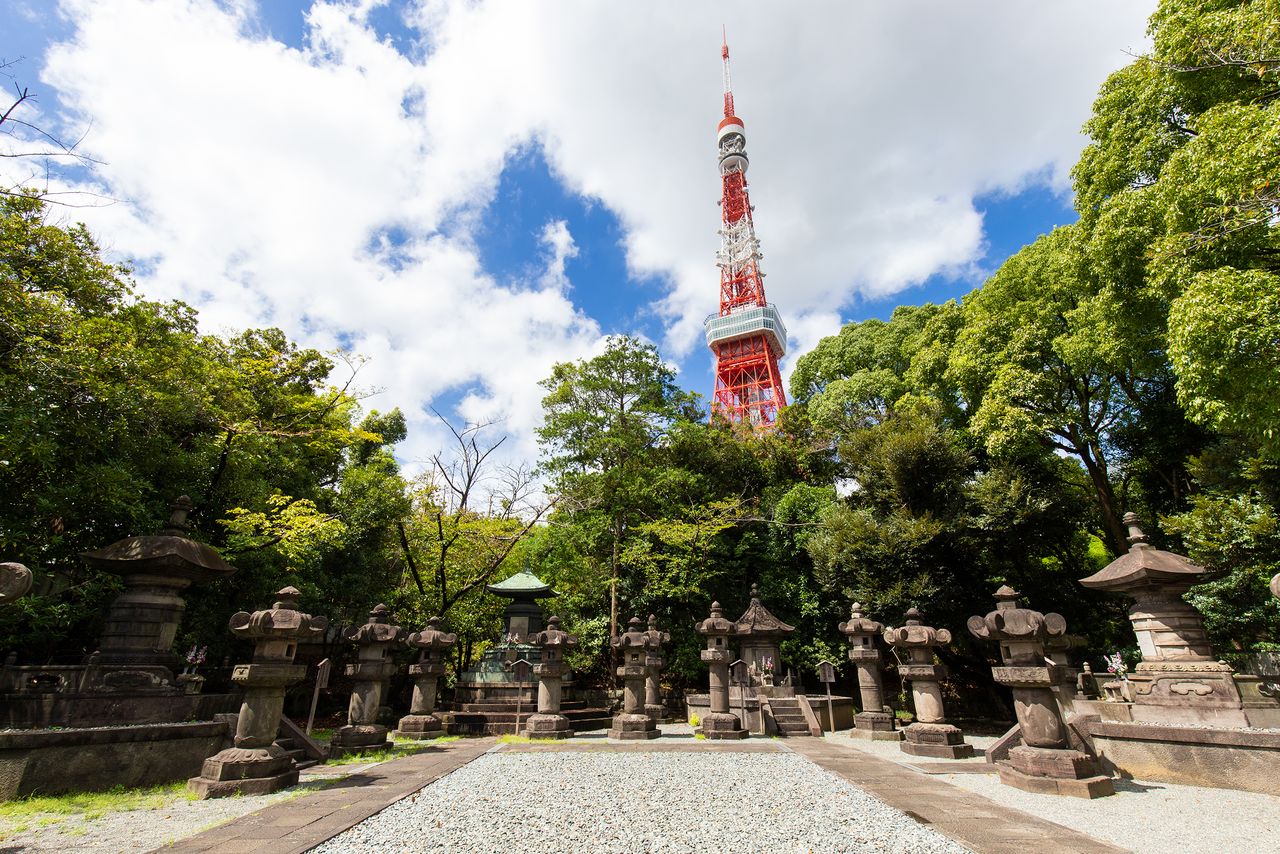
The graves of the six Tokugawa shōguns are joined by those of wives and other family members.
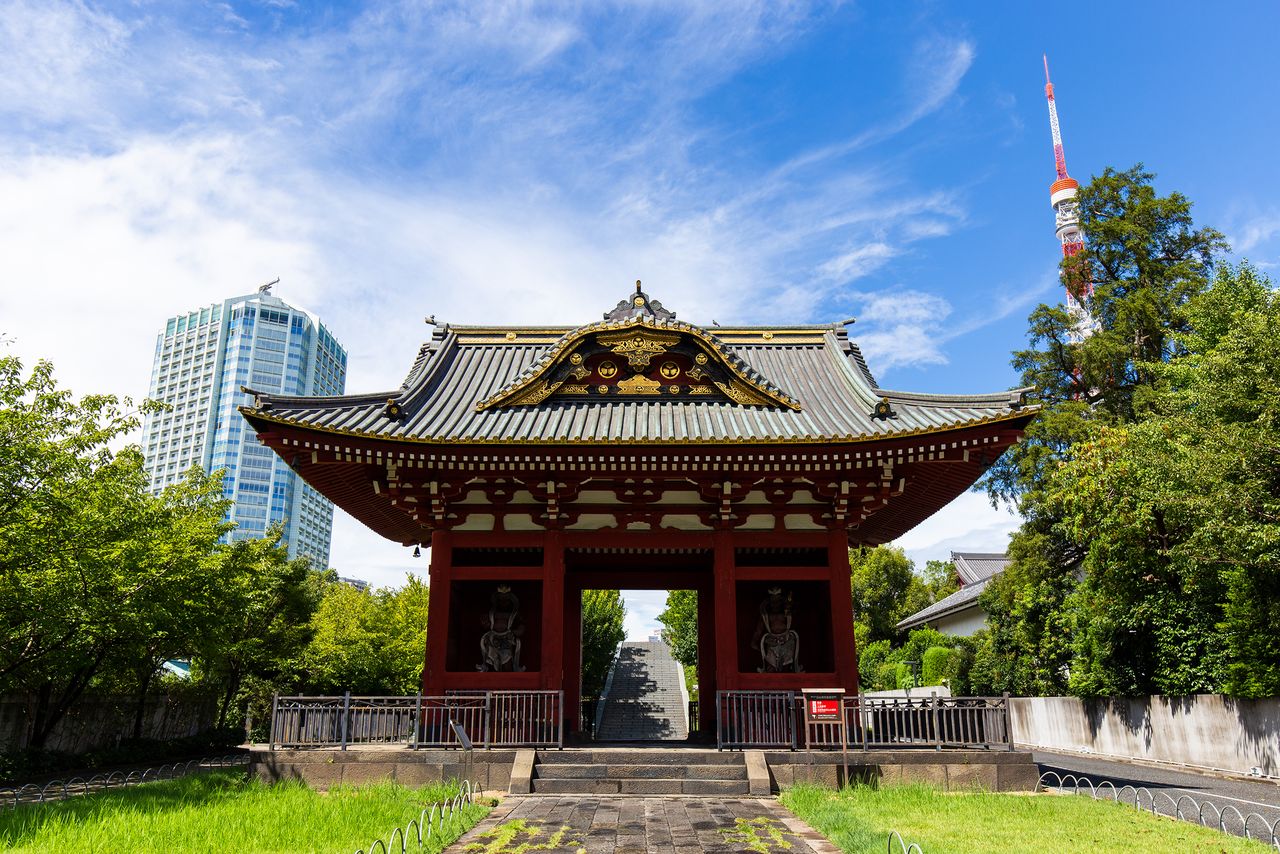
The graves of the six Tokugawa shōguns are joined by those of wives and other family members.
A Grand Temple
The present confines of Zōjōji are only a fraction of the nearly 83 hectares that existed at the temple’s peak. The numerous buildings and gardens that once stood on the sprawling precincts have been replaced by roads and modern concrete structures. At Zōjōji’s height, the Sangedetsumon was the so-called middle gate rather than the front entrance. The main gate, the Daimon, stood to the east at a distance of exactly 108 ken—some 200 meters—a figure corresponding to the number of earthly desires. Today, a much reduced replica marks where the great gate once was while the name Daimon lives on as a station on the Asakusa and Ōedo subway lines.
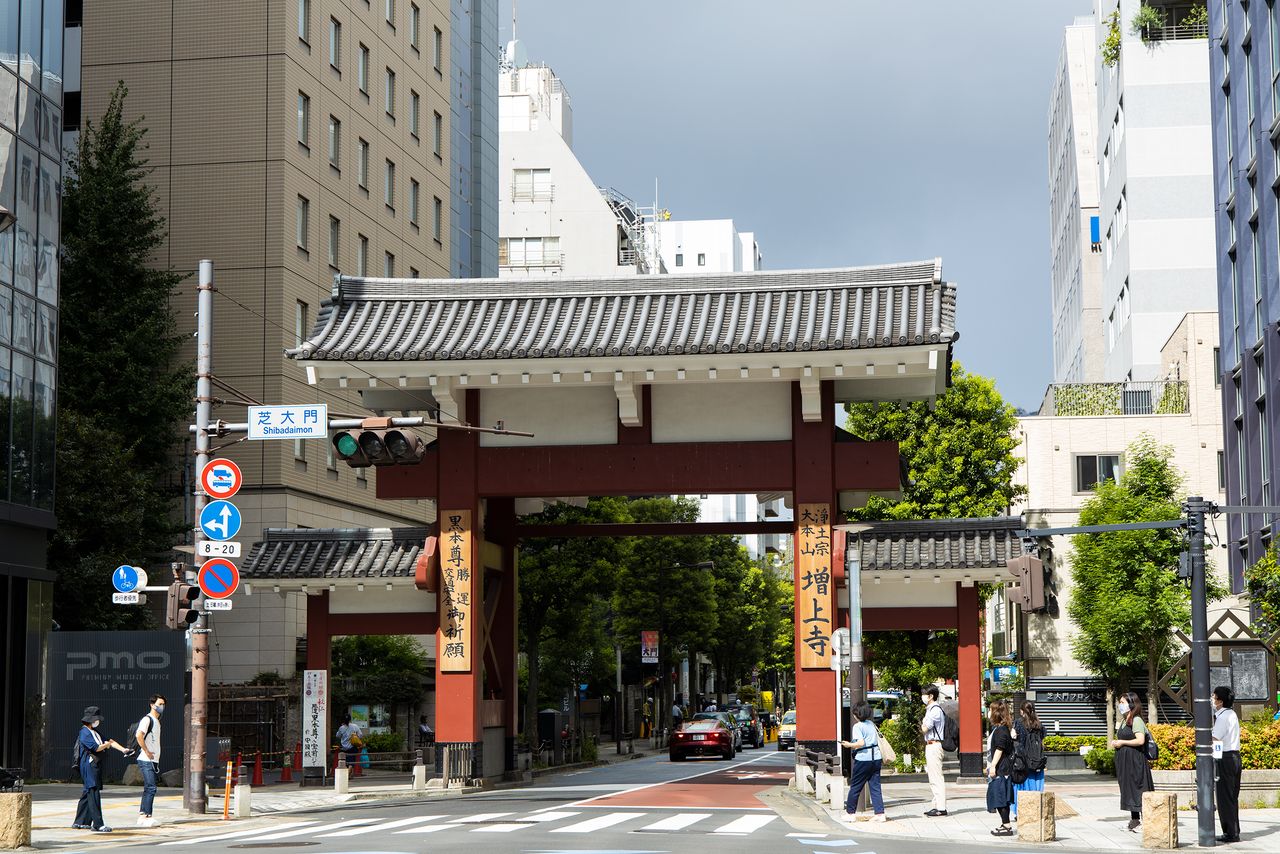
The Meiji government reduced the size of Zōjōji and donated the land to the newly founded city of Tokyo. In 2016, the metropolitan government returned the site of the Daimon to the temple.
The northern boundary of the temple stretched to the Onarimon, the dedicated gate for shogunal visits. Today, the area is marked by a namesake station on the Toei Subway Mita Line. Shiba Park and the hotel the Prince Park Tower Tokyo occupy what used to be Zōjōji’s southern confines and Tokyo Tower marks the border of the grounds to the west. There were 48 sub-temples on the vast precincts as well as over 100 structures to house the immense number of monks, upwards of 3,000 by some accounts, studying at the temple. Zōjōji also controlled estates in surrounding areas and further afield that assured it a substantial income.
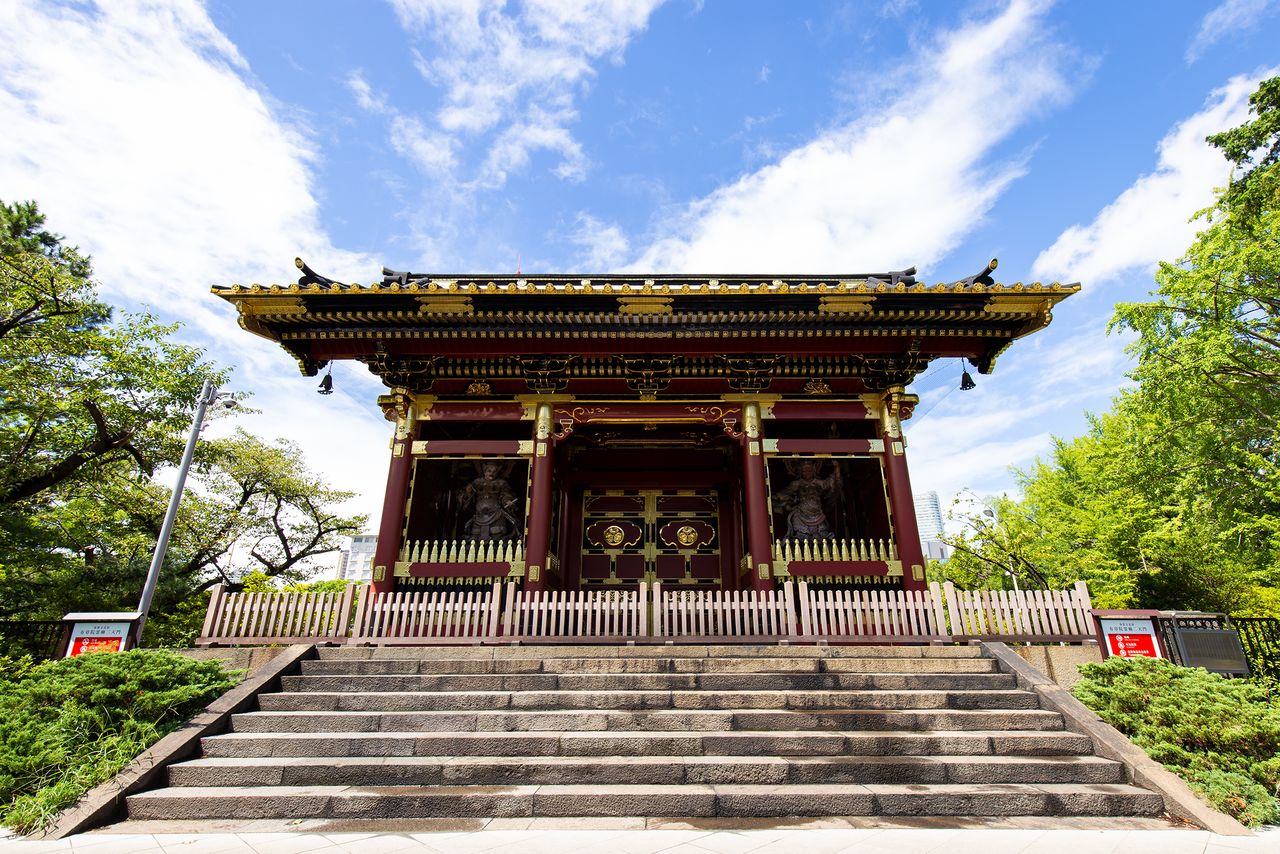
The Nitenmon once marked the entrance to the Yūshō-in, the mausoleum of the Tokugawa shōguns. Registered as a National Important Cultural Property, it now stands on the grounds of the Prince Hotel.
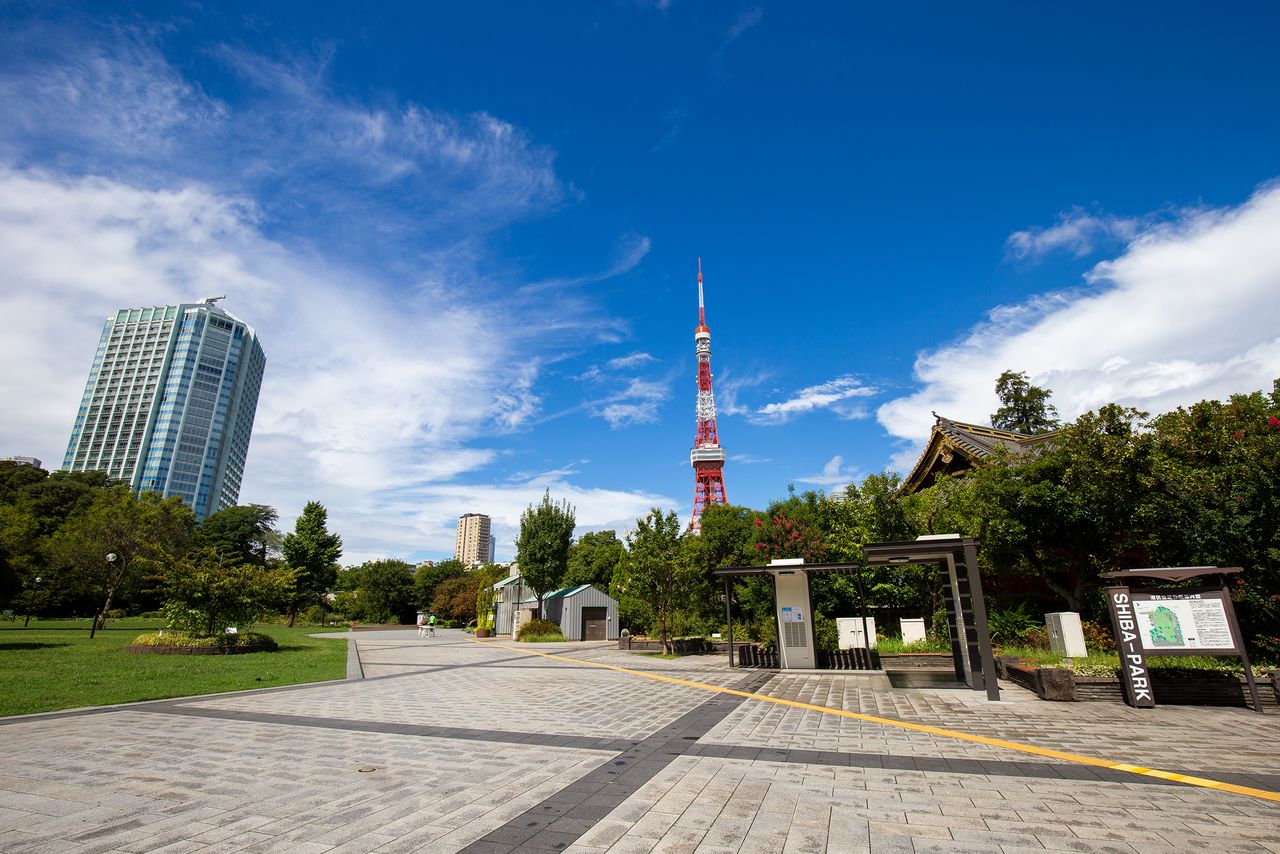
Shiba Park, one of Japan’s first public parks, was created on land that was part of the enormous grounds of Zōjōji.
Tokugawa Legacy
Relics of Zōjōji’s deep connection with the Tokugawa government are scattered throughout the temple grounds. On the north side of the temple is an ancient suibansha, a roofed cistern where worshippers purify themselves before praying. The stone container was originally part of the Seiyō-in, the mausoleum of shōgun Iemitsu’s son Tokugawa Tsunashige, lord of the Kōfu Domain, but was moved to its present location after the tomb was destroyed by fire. Directly opposite is a bell tower housing the Daibonshō. At the time of its casting in 1673, the Daibonshō was one of the largest temple bells in Edo and surrounding region.
Other artifacts related to the Tokugawa clan that have survived the wartime destruction are the Kuromon, a gate built sometime during the mid-seventeenth century, and a 200-year-old kyōzō (sutra repository).
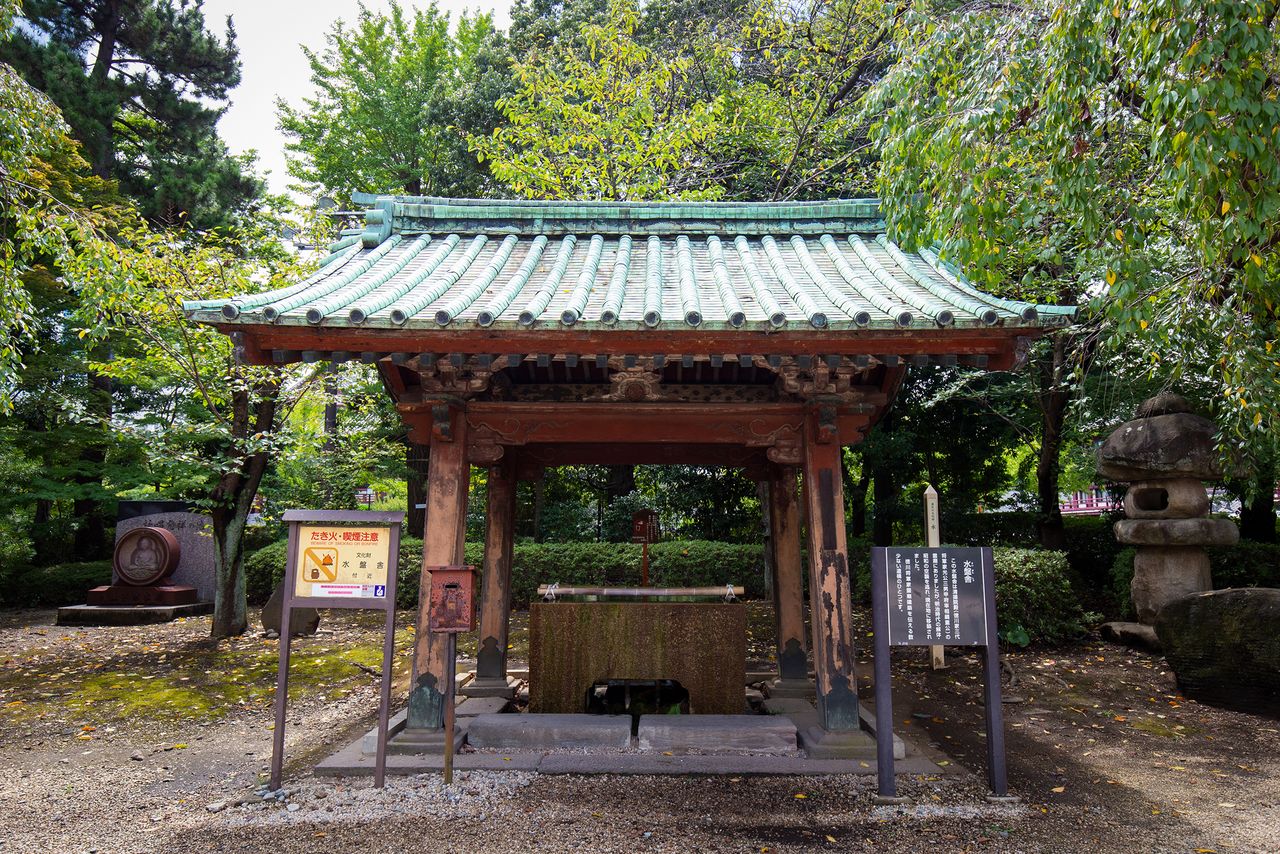
The cistern from the mausoleum of Tokugawa Tsunashige is still in use.
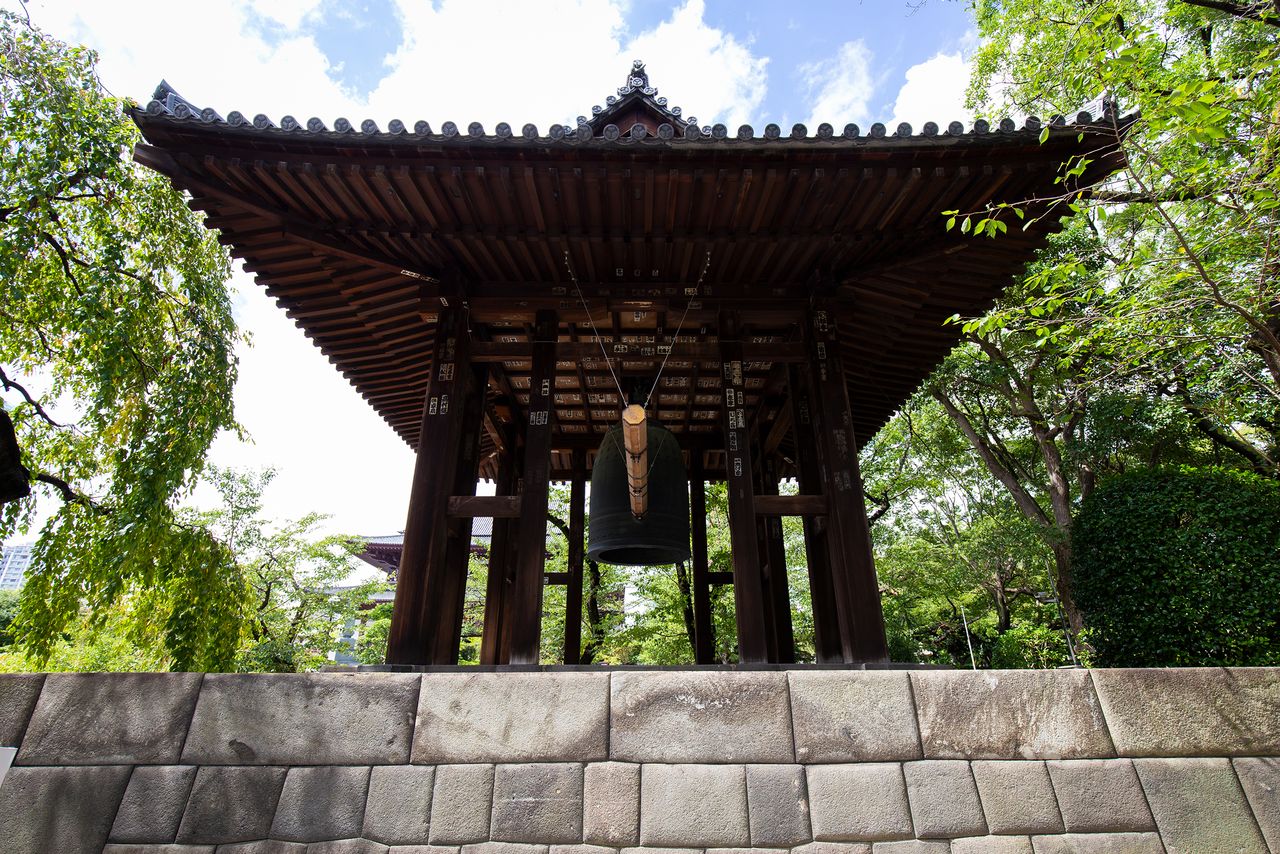
The Daibonshō was considered one of Edo’s three great temple bells.
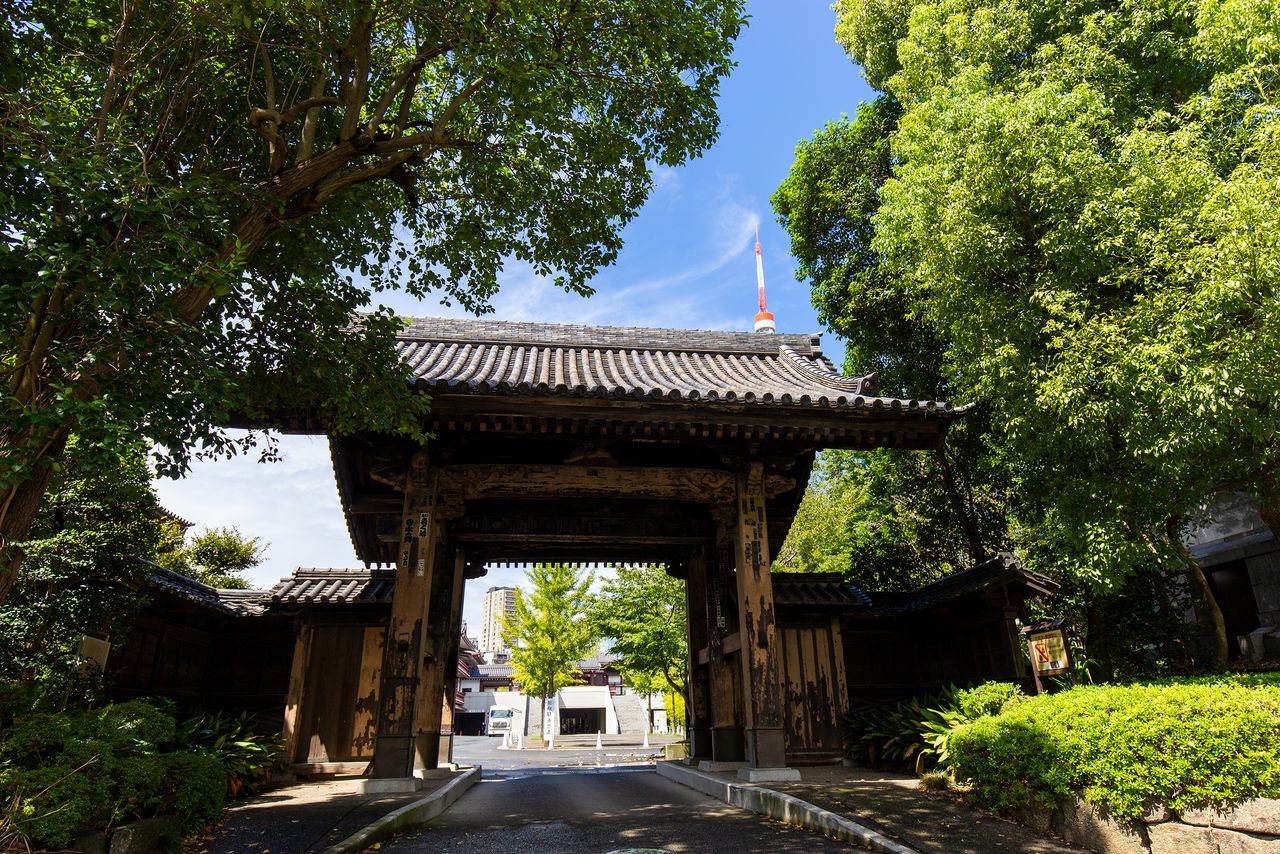
The Kuromon to the south of the Sangedatsumon was commissioned by third shōgun Iemitsu.
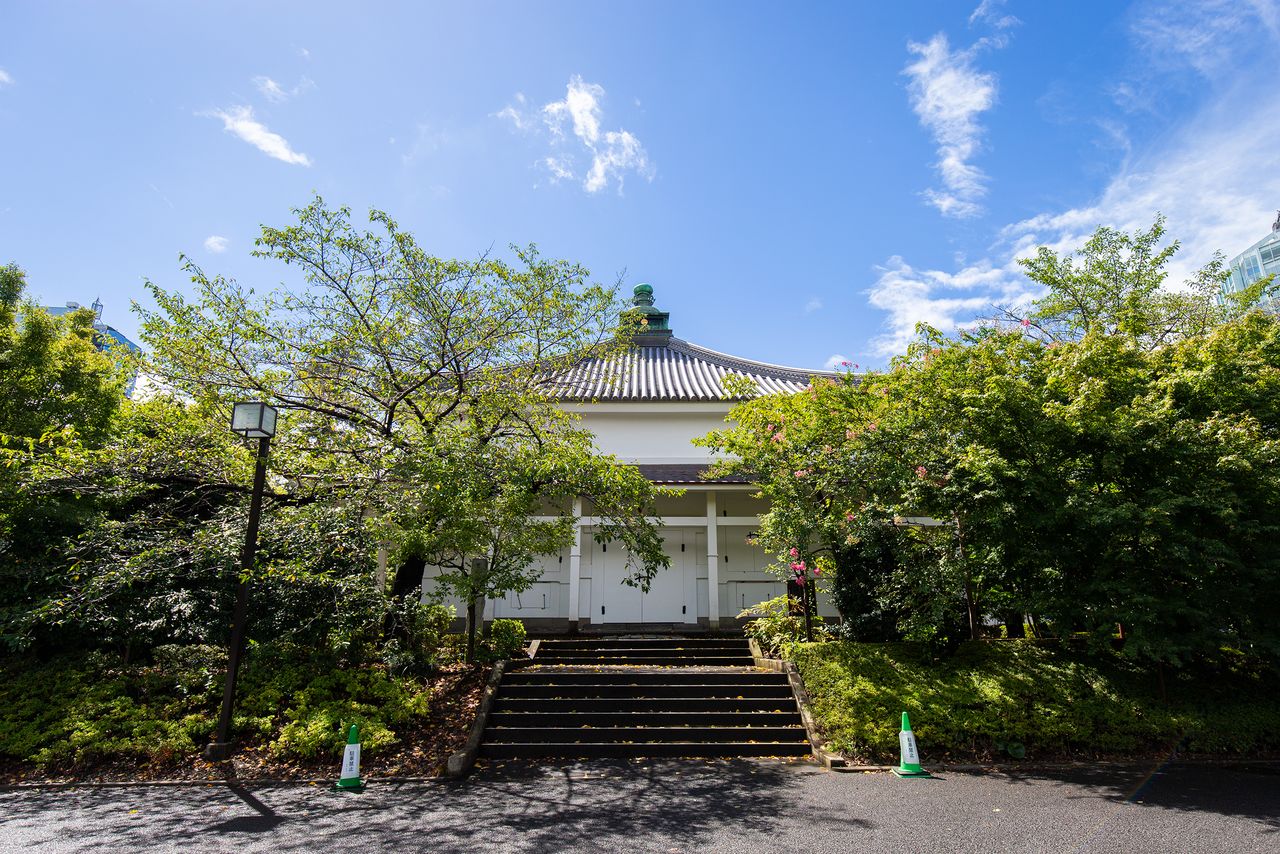
The sutra repository at Zōjōji, originally built in 1613, was reconstructed in 1799. It is registered as a Tokyo Cultural Property.
Adjacent to the Daiden is one of Zōjōji’s other prominent halls, the Ankokuden. The building houses a black image of Amida Buddha that is said to have been carved by the priest Genshin (942–1017), whose writings were influential on the spread of Pure Land Buddhism. Ieyasu is supposed to have venerated the carving and would come to pray before it.
The most prominent symbol of Zōjōji’s connection to the Tokugawa clan is the mitsuba aoi, the Tokugawa family crest of three hollyhock leaves that adorn items like roof tiles, gates, and stone carvings throughout the temple grounds.
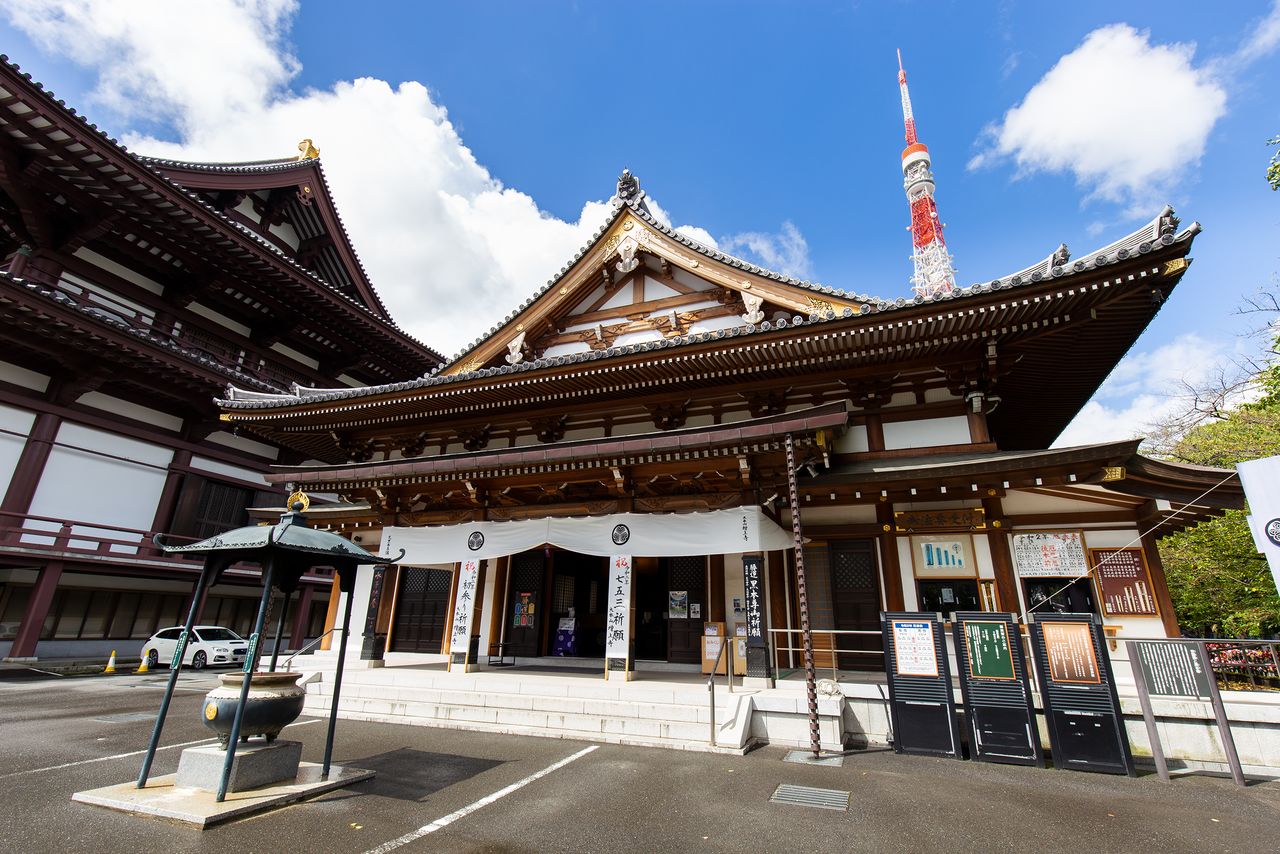
The Ankokuden was named after Tokugawa Ieyasu’s Buddhist title, Ankokuin. Visitors can purchase charms and items used for various Buddhist services at a dedicated stall.
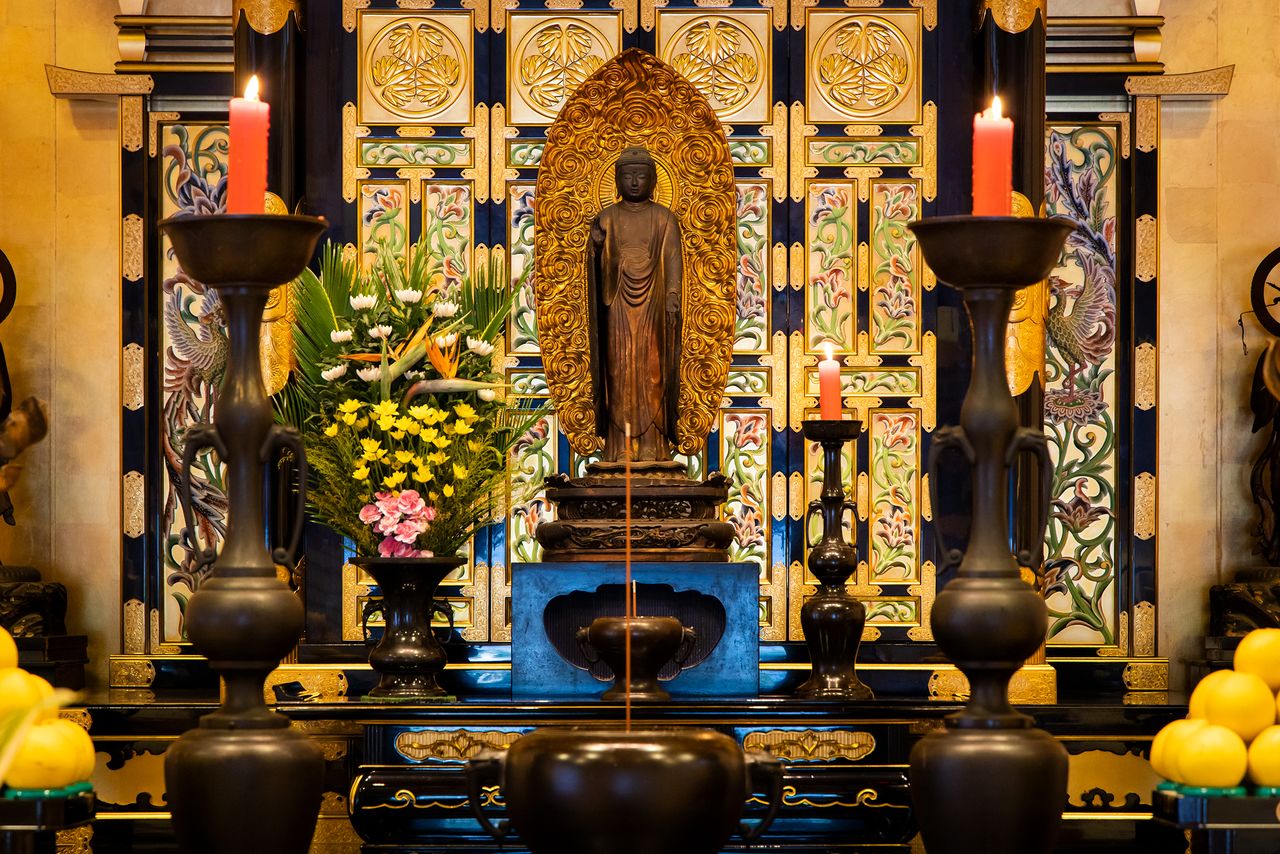
The black image of Amida Buddha is displayed to the public three times a year, on the fifteenth of January, May, and September.
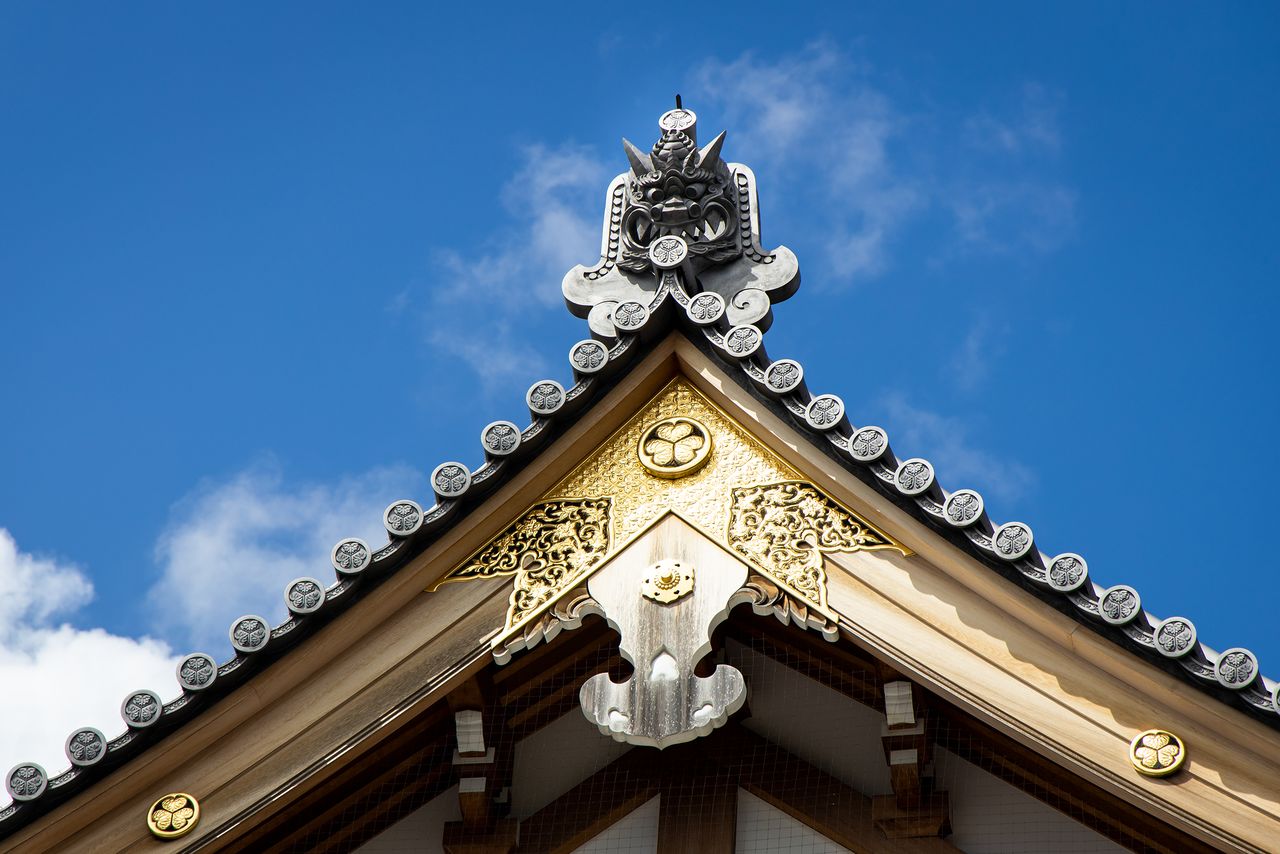
The Tokugawa family crest with its iconic three hollyhock leaves is visible under the ogre-faced onigawara tiles on the roof of the Ankokuden.
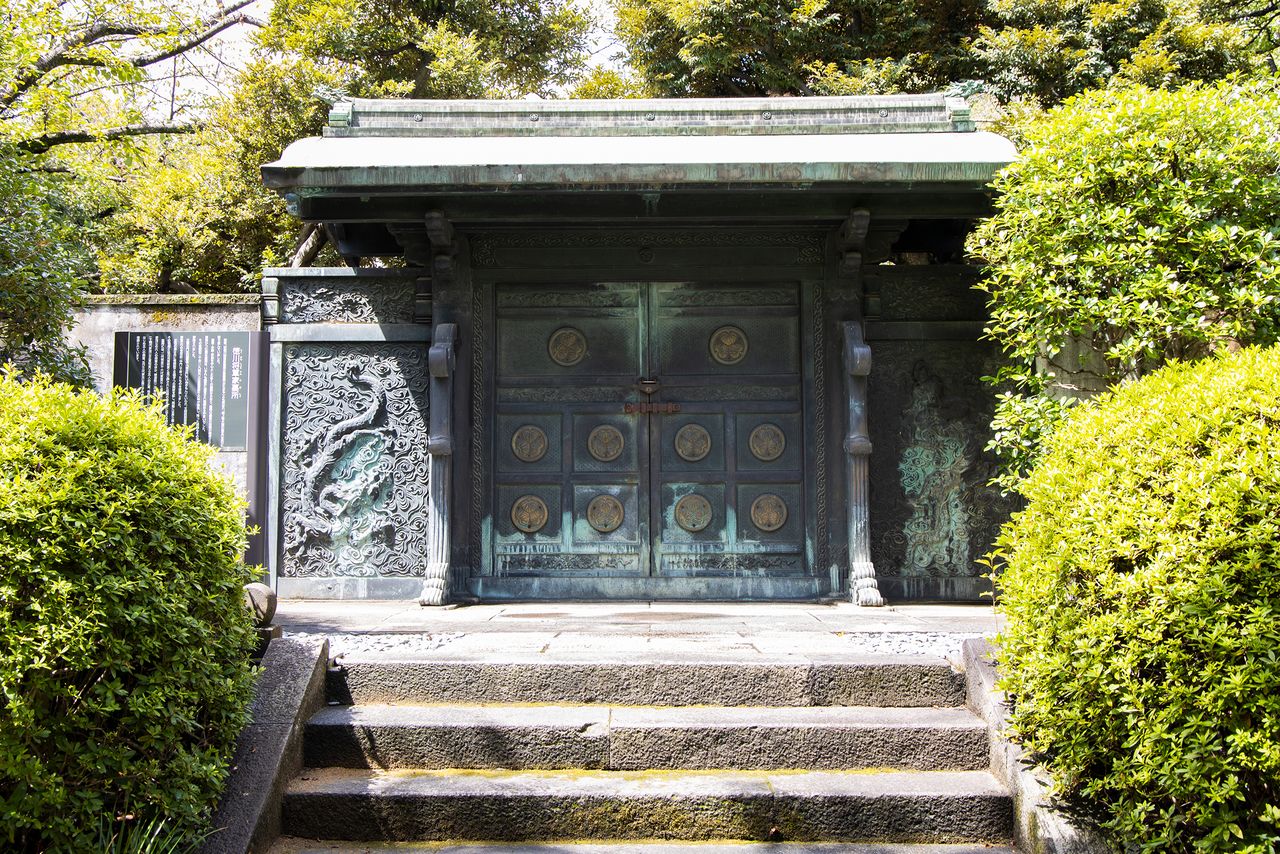
The Inukimon, the bronze gate of the mausoleum of the Tokugawa leaders, was originally part of the tomb of sixth shōgun Ienobu.
A Repository of Edo History
The grounds of Zōjōji are also home to a wide array of historic reminders of the temple’s religious and cultural importance. Tucked away in the northeast corners is the Yuya Shrine, established in 1624, and on the western side of the precincts is a tea house associated with Princess Kazunomiya, wife of fourteenth Tokugawa head Iemochi. There are also numerous lanterns and stone monuments, including one dedicated to fallen members of Edo’s legendary megumi fire brigade. Matsunaga says the rows of Jizō figures, the sentai kosodate Jizō, clad in red caps and bibs are especially popular among visitors from overseas. The small stone statues, of which there are some 1,300, were offered as prayers for a child’s health and as part of mizuko services for the souls of lost fetuses.
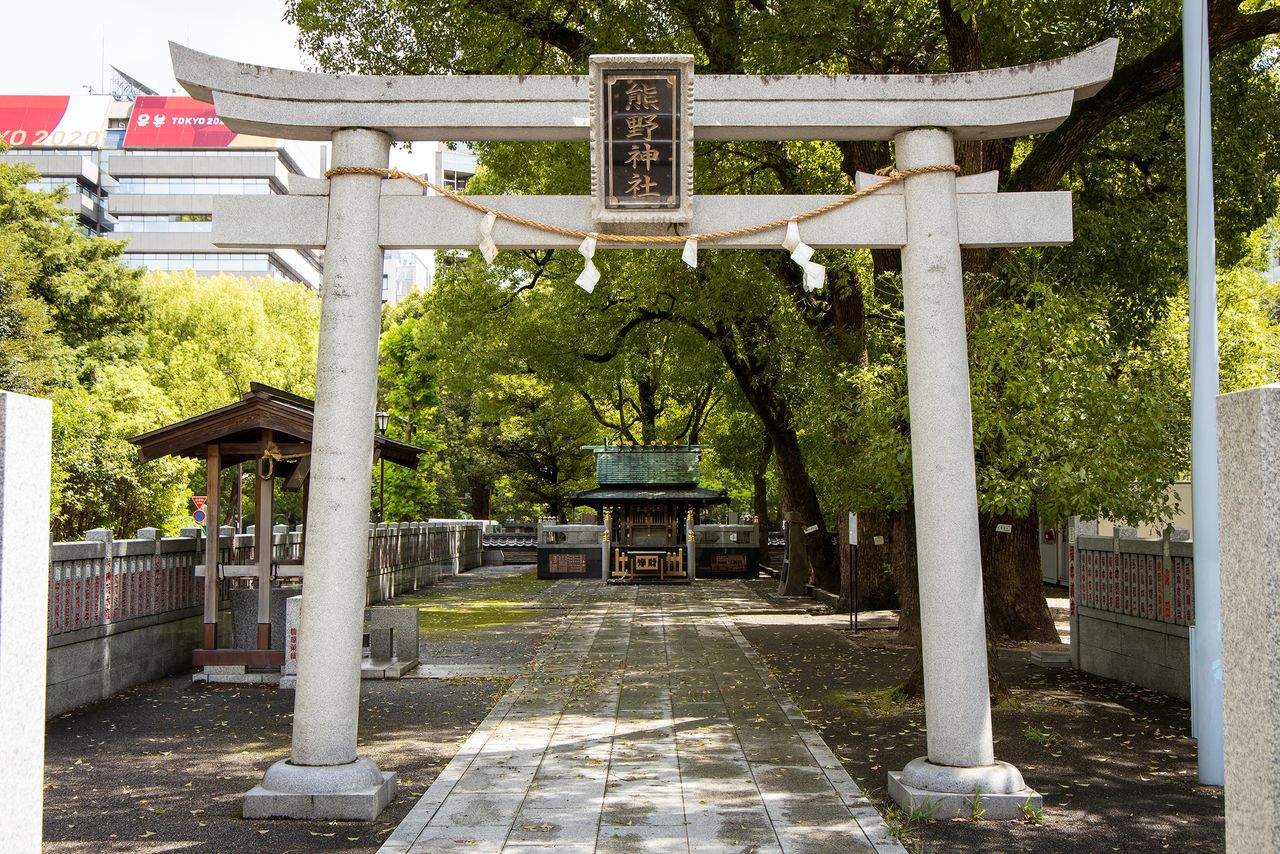
The entrance to the Yuya Shrine.
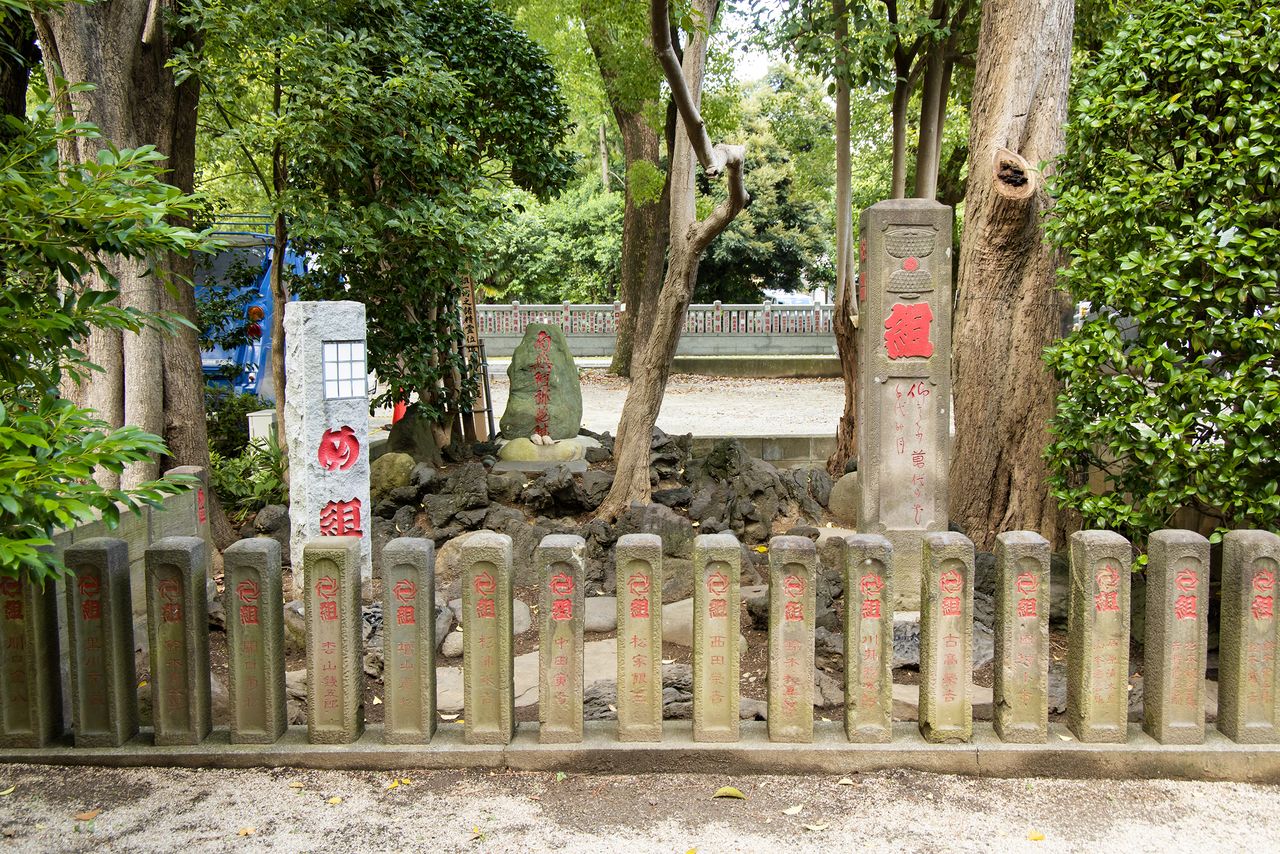
The stone monument to Edo’s megumi fire brigade was dedicated in 1716.
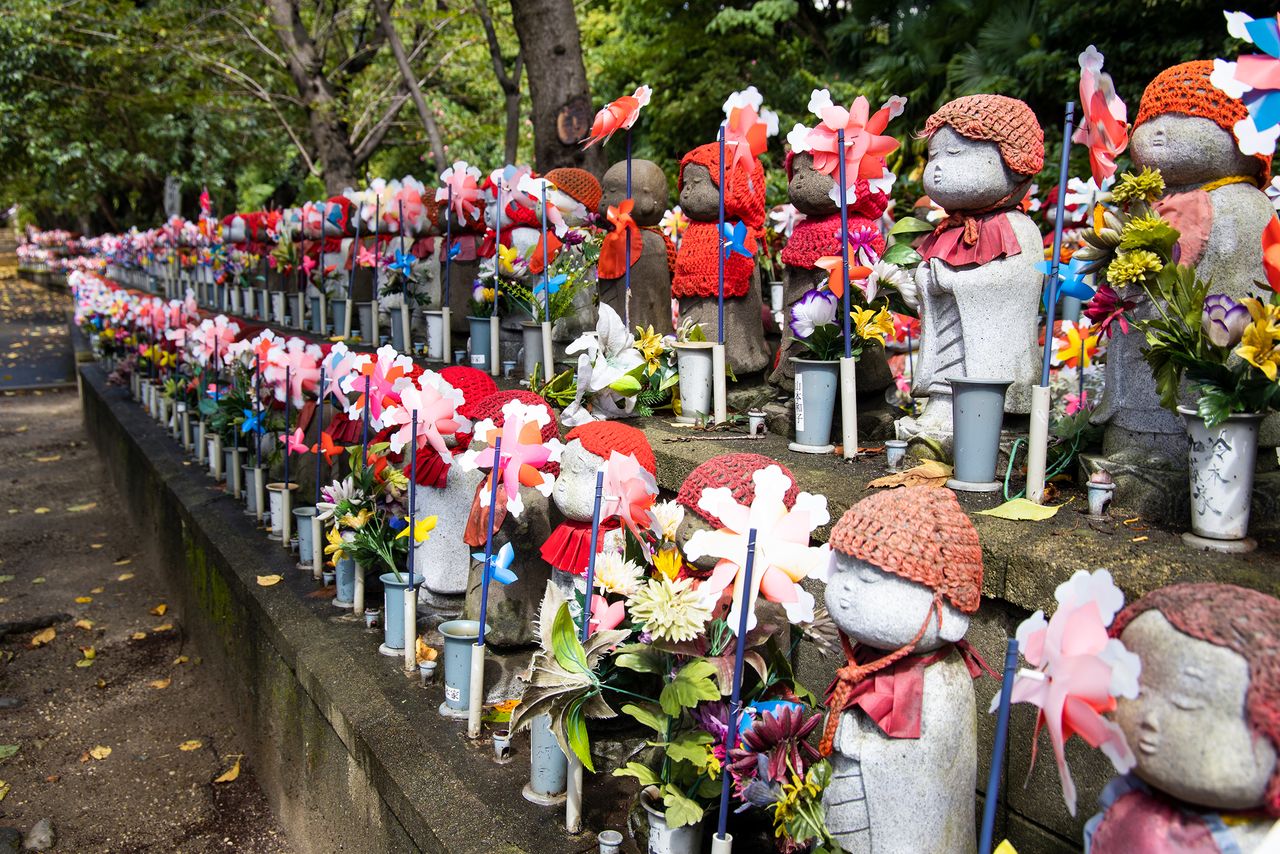
Pinwheels and offerings of flowers and toys decorate the rows of Jizō statues.
Matsunaga recommends that after exploring the temple grounds, visitors tour Zōjōji’s Treasure Gallery on the ground floor of the Daiden. The museum houses an array of artworks and relics pertaining to the history of the temple. The centerpiece is a one-tenth-scale replica of Hidetada’s mausoleum, the Taitoku-in, which is said to have been the model for the Nikkō Tōshōgū. Constructed by staff and students at the Tokyo Fine Arts School, the predecessor of today’s Tokyo University of the Arts, it was displayed at the Japan-British Exhibition in London in 1910 and remained part of the British Royal Collection for over a century. It was gifted to Zōjōji and put on display when the Treasure Gallery was opened in 2015, the 400th anniversary of Ieyasu’s death.
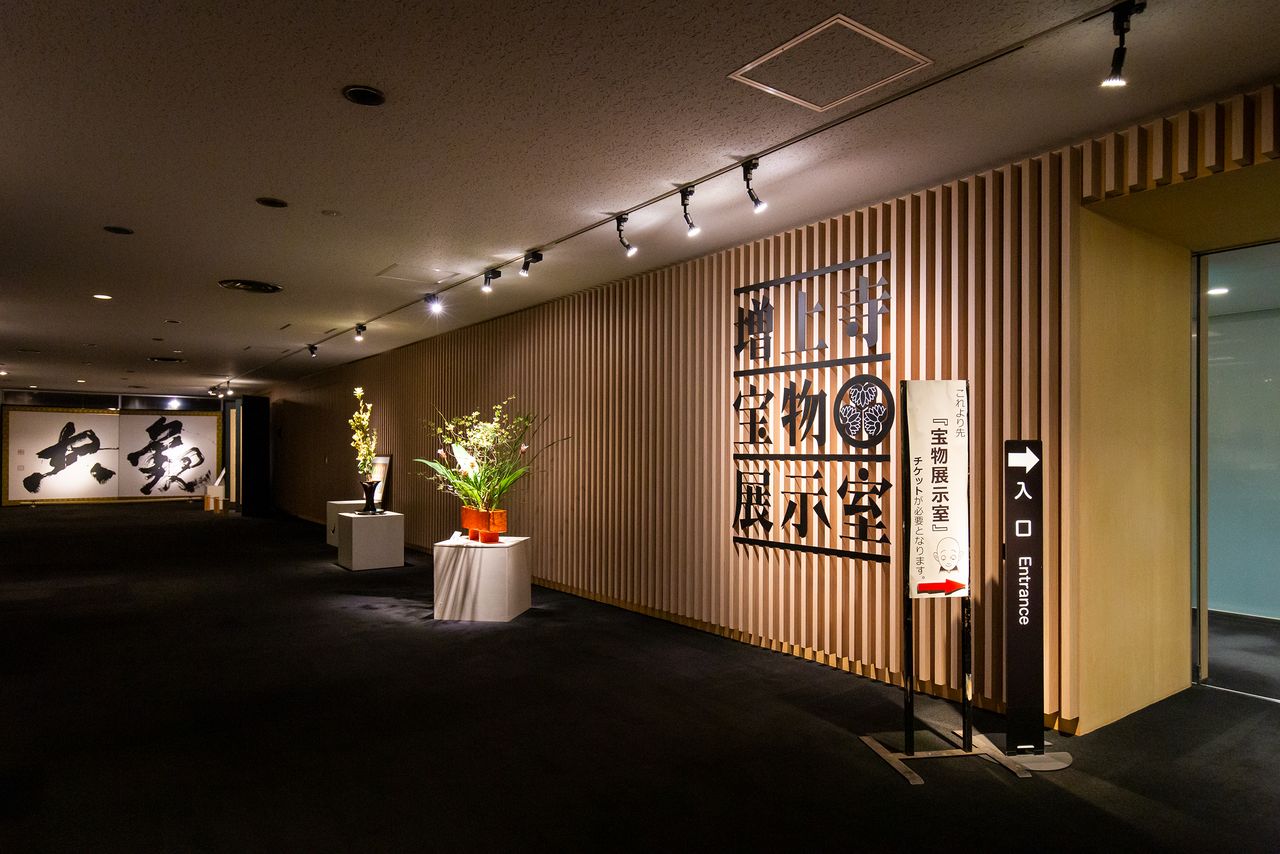
The lobby of the Treasure Gallery displays works by calligrapher Yanagida Taiun and artist Shinoda Tōkō.
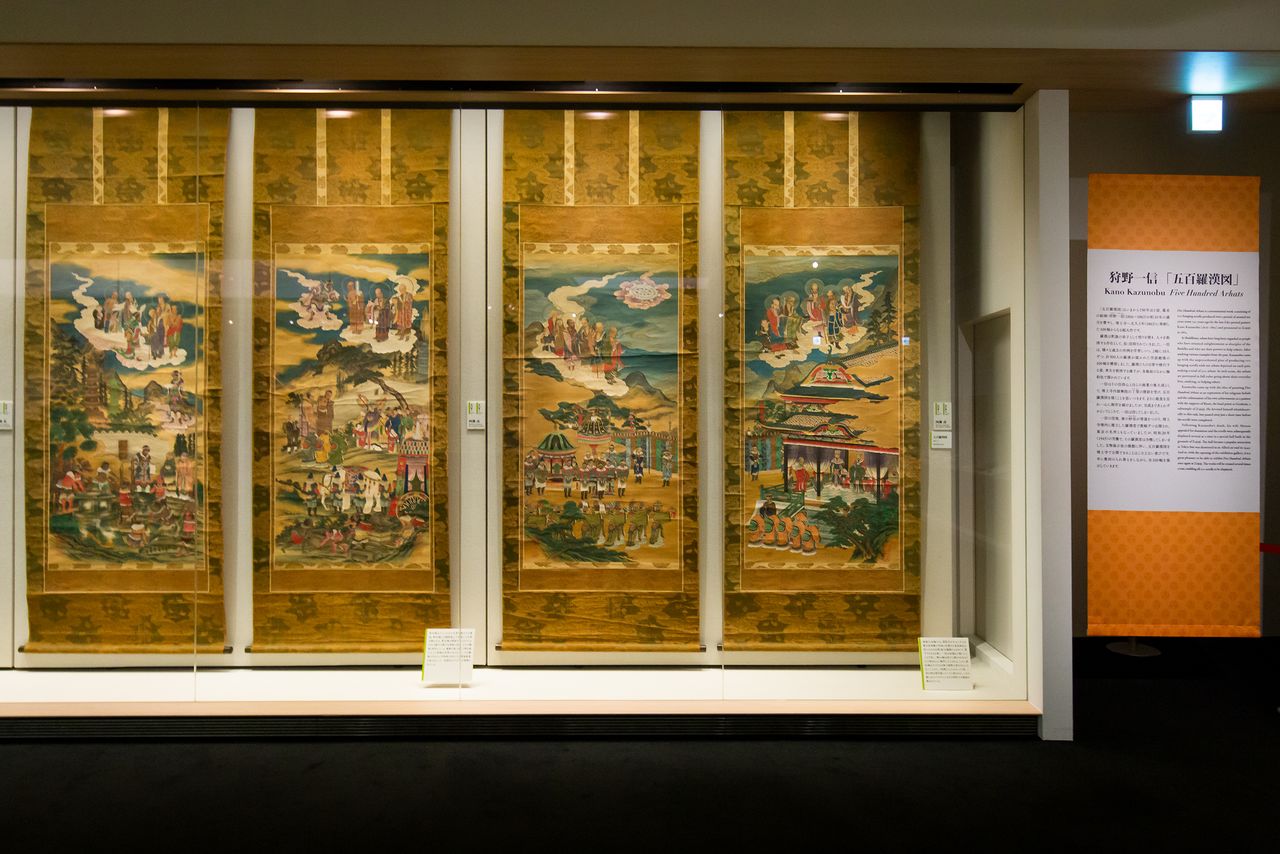
Works from a set of 100 hanging scrolls by Edo-period artist Kanō Kazunobu depicting 500 disciples of Buddha.
A Center for Buddhist Learning
Matsunaga admits that Zōjōji could do more to attract tourists, but he insists that the temple’s primary roles remains as a headquarters for Jōdo Buddhism in the Kantō area. Along with Kyoto’s Chion-in, it is one of only two temples where candidates must undergo a final three weeks of training prior to being ordained priests. Each year, around 100 priests complete their studies at Zōjōji and are appointed to other temples around the country.
The year 2025 will mark the 850th anniversary of the founding of the Jōdo sect. Matsunaga says that work is currently underway to replace the roof tiles of the Daiden and that the Sangedatsumon is scheduled for renovation in preparation for this important occasion. “I sincerely hope that tourists and the followers of Jōdo alike will continue to come to see Zōjōji—and Tokyo Tower—for many, many more years to come.”
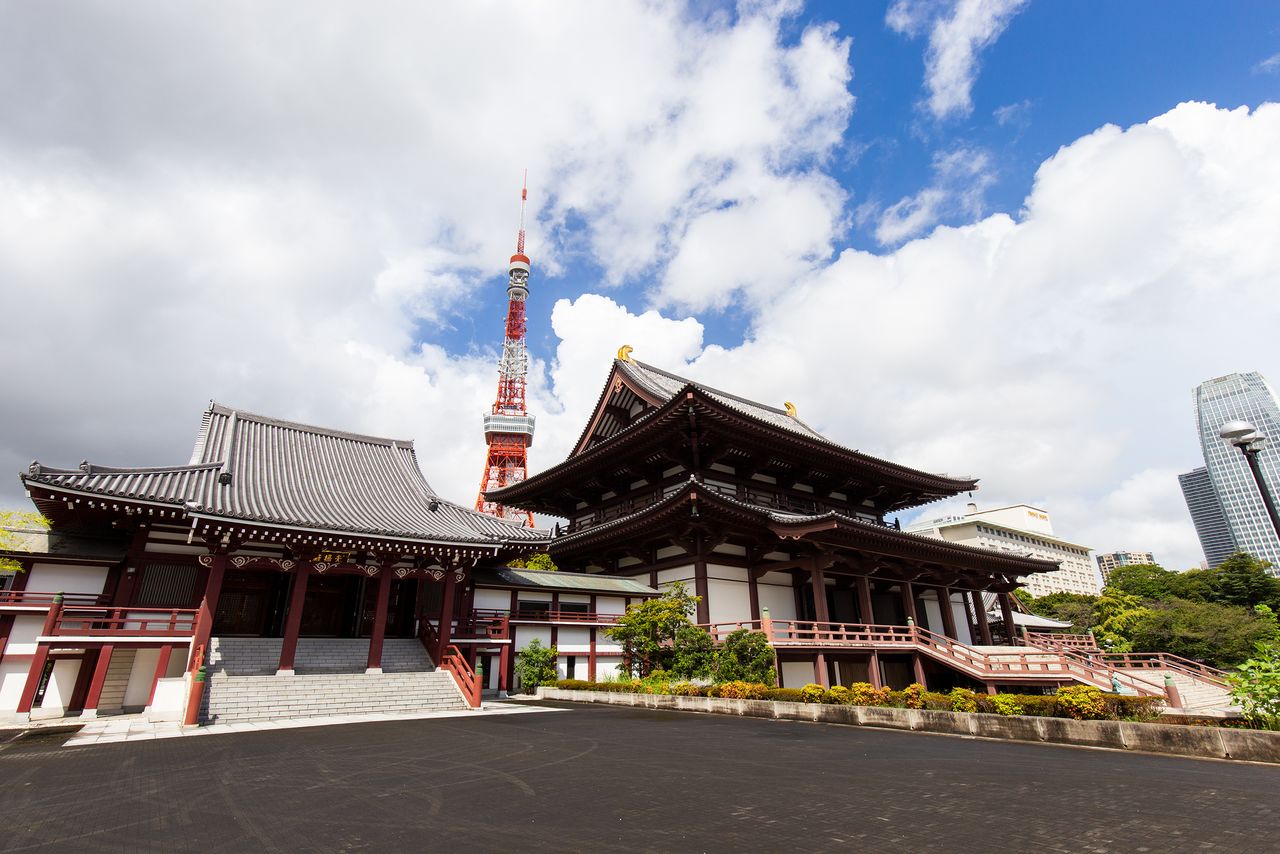
The Kōshōden to the left of the Daiden is where prospective priests come to study.
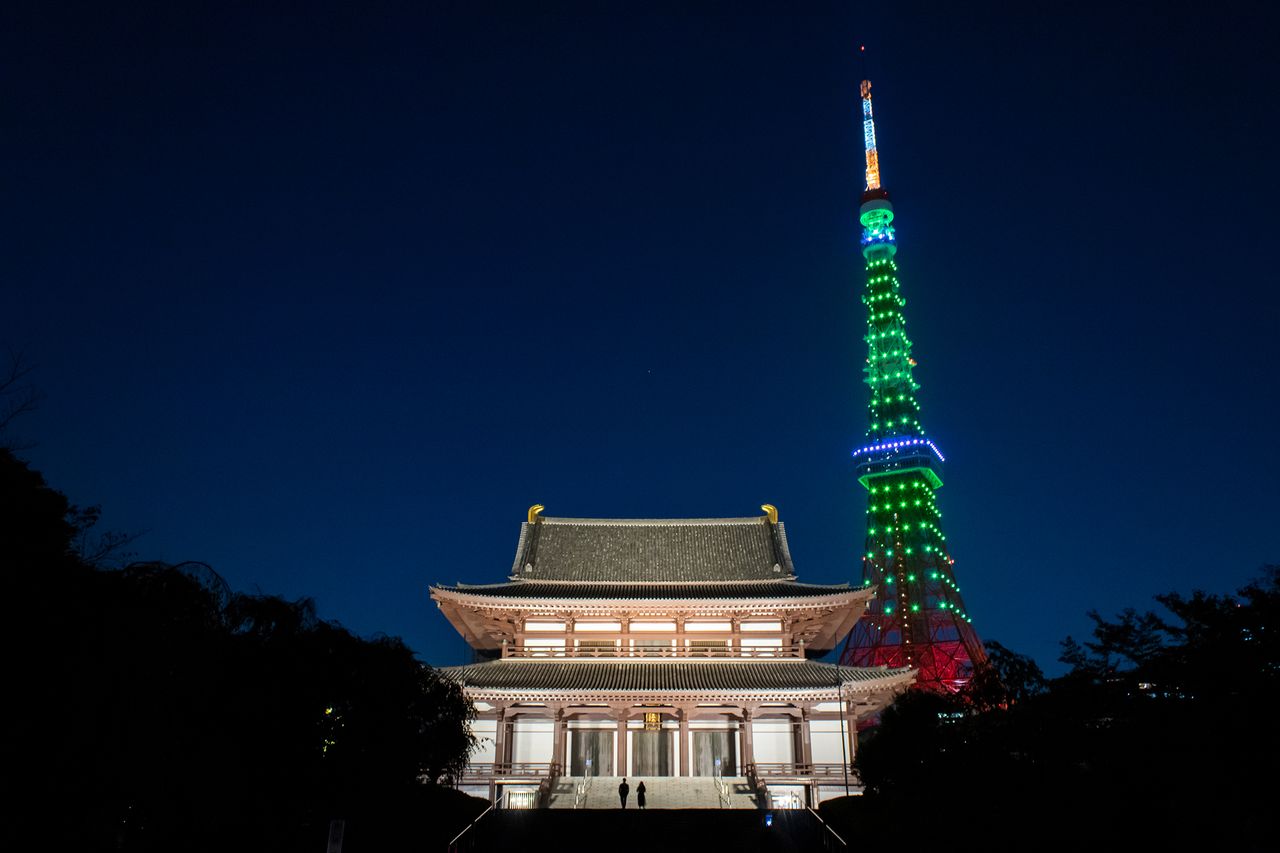
Zōjōji’s Daiden and Tokyo Tower illuminated at night.
Zōjōji
- Address: 4-7-35 Shiba Park, Minato, Tokyo
- Worshipping hours: Daiden 6:00 am to 5:30 pm; Ankokuden 9:00 am to 5:00 pm
- Mausoleum of Tokugawa Shōguns: Weekdays 11:00 am to 3:00 pm; weekends and holidays 10:00 am to 4:00 pm; closed Tuesdays unless a holiday; adult admission ¥500
- Treasure Gallery: Weekdays 11:00 am to 3:00 pm; weekends and holidays 10:00 am to 4:00 pm; closed Tuesdays unless a holiday; admission ¥700
- Getting there: A 3-minute walk from Shibakōen and Onarimon Stations on the Toei Subway Mita Line; 5-minute walk from Daimon Station on the Toei Subway Asakusa and Ōedo Lines; 10-minute walk from JR Hamamatsuchō Station and the Tokyo Monorail
(Originally published in Japanese. Reporting, text, and photos by Nippon.com.)